How Pilots Get to Know the Backwaters of the Globe
The world, collapsible , the most absurd and wonderful perk of piloting..

Photo by Mark Vanhoenacker
All week, Mark Vanhoenacker will be sharing stories about piloting and planes excerpted from his book Skyfaring: A Journey with a Pilot . Out now from Knopf.
A pilot may acquire an affectionate awareness of a kind of punctuation or asterisking of the world, composed of the names of small places, places that almost no one other than pilots will have reason to think of regularly.
Many geographic milestones are elevated this way because they are home to radio beacons. It’s hard not to think of older beacons, lit to help navigate, as with lighthouses, or to transmit warnings, as with the news of the sightings of the Spanish Armada, or to celebrate events such as coronations and jubilees. In the 1920s hundreds of light beacons, often placed high on mountaintops, inaugurated the first transcontinental airmail flights, from New York to San Francisco. This cross-country trail of light echoed the railroads, of course, but also the Pony Express, as pilots and planes would change en route, allowing letters to make an almost continuous journey from one coast to the other. There was even talk of a “lighted airway” across the Atlantic for dirigibles. Today, particularly in the western United States, some of the radio beacons used by modern airliners are sited just where those original light beacons once stood.
Near the tip of Cape Cod, Massachusetts, on the ocean side, stands a beacon that is a curiosity to those walking near the beach and that shares a name, appropriately, with Marconi, the Italian engineer known as the father of radio. Beacons like this one and the plane speak to each other, like children playing Marco Polo in a pool. The plane counts the time between its call of “Marco!” and the beacon’s reply of “Polo!” and so calculates the distance between them.
Pilots can manually tune a beacon and see our distance and bearing from it, a basic, old-school check of our position. But in the background a modern aircraft is always searching for them, like a driver in an unfamiliar town constantly seeking landmarks and street signs. Beacons have only a certain range, and when the aircraft finds one, its codes may flicker to life on one of our screens, and in this way we come to know the names of many of the beacons of the world.
The Slate staff’s questions about flying answered by British Airways pilot Mark Vanhoenacker.
In the more remote regions of the world beacons and airports often coincide; the beacon is there because the airport is there. When such a place is surrounded by nothing else that relates to aviation, its isolation lifts it into unexpected prominence in the sky. In Greenland is the airport named Aasiaat. It is on a bay I would like to visit one day, because it bears the marvelous name familiar to armchair atlas ponderers, long-haul pilots, and almost no one else: Disko Bay. The names of many small places in the far north of Canada have the quality of making bitterly cold water sound warmer than it can ever be—Pond Inlet, Sandy Bay, Hall Beach, and Coral Harbor.
Some beacons are in places that although famous are geographically incidental; you might not expect them to be elevated on aviation charts in a manner so independent of their historical prominence. Point Reyes is the name of a lighthouse on the Northern California coast; a beacon near it, known by the same name, features on arrivals in San Francisco. Robben Island, off Cape Town, South Africa, where Nelson Mandela was incarcerated, was a prison even in the 17 th century. It’s home, too, to a beacon of the same name, which appears on charts for Cape Town’s airport and forms part of an often-used arrival pattern.
I have a Canadian friend from a small town in interior British Columbia. When I first asked where she was from, she laughed and shook her head and said I would not know it; it was a tiny town where they didn’t close the school unless the temperature was colder than minus 40 degrees Fahrenheit. But when she said the name of this small place, Williams Lake, it was my turn to smile and say: “I know Williams Lake; I gaze on it every few months. There’s a navigation beacon there.” When I see her, if I have flown over it recently, I will tell her if it was cloudy or if I could see her hometown resting between the Rockies and the Coast Range.
A pilot’s awareness that the whole world is possible is most acute when on standby. Sometimes these standby duties take place at airports, but often they are assigned at home, where we are required to be reachable by telephone and to be within a certain travel time of the airport. When another pilot cannot make it to work—illness, a child-care problem, a flat tire—then a standby pilot is called. Sometimes by the time I reach the airport the passengers have already boarded, the fuel and cargo are loaded, and staff are standing by the airplane’s last open door, waving their hands at an oblique angle that suggests both a greeting and the direction in which I should keep moving, through the airplane door that they will close as soon as I pass through it.
When I’m on standby I have a bag permanently packed, with both winter gloves and a bathing suit amid the uniform shirts, a bag for all lands, all seasons. I’ll be at home cleaning or at the supermarket or running in the park when my phone will ring and a voice tells me that I’m bound for Bangkok or Boston or Bangalore, India. I return home, pick up my bag, and fly there.
Occasionally I think that the more broadly you wish to experience the world, the more certain it is that you would enjoy being a pilot, even if flying itself isn’t your first love. Alfred de Musset, in a sonnet dedicated to Victor Hugo, wrote that in this “low world” you should love many things, in order to know at the end the thing you love best.
He lists some things we might love. He includes the sea and the blue of the heavens, and few pilots would disagree. But a pilot might also take the “low world” more literally. If you are interested in motorcycling or urban design, opera or kite surfing, hiking or languages, the whole world of these things opens to you, at least on long-haul trips, where even if you are able to fall asleep for the half day after arrival and before departure, you often have an entirely clear day or two in between. In many cities—Bangkok, Mexico City, Tokyo—cooking schools offer short courses that are popular with pilots and cabin crew, an opportunity to ground ourselves in the tastes of a new place and to do the cooking that a life of hotels and restaurants cuts us off from. Sometimes everyone at such a class works for one airline or another, sharing a few hours and a table in a far place.

Many of the pursuits that fill our off-duty hours are aligned with the natural world. I have flown with pilots who explore botanical gardens wherever they go or put time changes to good use by rising early to photograph sunrises. If you have an interest in wildlife, you will have the opportunity to see pandas or elephants or tigers or whales where they live or to see birds in one season and continent and then later in another; to overfly their migrations and wait for them somewhere else. You might read a book about the great trees of the world and a few years later have stood under many of them in their original habitats.
I don’t mean to diminish the many challenges of the job—the initial training costs that burden most new pilots with home mortgage–sized loans; the days and nights and holidays so far away from family and friends; the irregular schedules that make regular commitments to neighbors or local sports teams or community organizations so challenging; the permanent regimen of biannual, multiday simulator exams; the physical stresses of unpatterned night shifts, time-zone changes, and other circadian upheavals; and the knowledge that our livelihood can vanish entirely in the furrowing of a doctor’s brow during one of our regular medical checkups. Flying is work in every sense. (“The reason you fly,” admonishes the father of Jonathan Livingston Seagull, “is to eat.”) But there are few jobs, I think, whose side rewards are so varied—as wide as the whole world—and so freely determined by the individuals involved.
One of my own interests when I am away for work— downroute, as we say—is hiking, which seems to help with both place lag and jet lag, although whether this effect is due to the exercise or the simple act of placing my boots on the soil, I do not know.
I’m walking in a park in South Africa; it is hot and dusty; I am here with several of the flight attendants and the pilots. The soil is red, and the sky is blue; we are sleepy, but the sun and conversation keep us awake. It was nearly freezing when we left London last night; overcast, late autumn, the anti-icers running on all the engines for takeoff. Dawn came over Botswana, and as we descended together toward Johannesburg a few hours ago, we saw this land below, this color, smoothed to perfect abstraction and running to the horizon as the sun rose on this spring morning in southern Africa. Now I’m walking on the land we crossed over. This soil gusts up in small crimson clouds with each step of mine that falls on it. A colleague points to a tree, to a weaver nest hanging from a branch; he tells me that the birds are named for their skill in making these nests.
It’s four days later. I’m at home, standing sleepily by the sink. The water runs over the soles of my sneakers, sweeping the African dust brightly over the stainless steel. I have to say it in my head, practically spell it out: “This is the red of the soil under the South African tree, from the morning I saw the weavers and their nests.” People become quickly accustomed to peculiar aspects of any job. I try hard to remember that this is an unusual experience of the world—to have stood on the earth there, then there on it and there, then suddenly to find myself alone on an ordinary afternoon, quietly washing it from my shoes.
Also in Skyfaring:
Why the 747 Is So Revered by Pilots
What Airline Pilots Think of Their Passengers
Excerpted from Skyfaring: A Journey with a Pilot by Mark Vanhoenacker. Copyright © 2015 by Mark Vanhoenacker. Excerpted by permission of Alfred A. Knopf, a division of Random House LLC. All rights reserved. No part of this excerpt may be reproduced or reprinted without permission in writing from the publisher.
Listen to Julia Turner talk to Mark Vanhoenacker on Slate ’s Working podcast:

- Discover more Shimano
- BRASIL PORTUGUES
- HISPANOAMÉRICA ESPAÑOL
- DEUTSCHLAND DEUTSCH
- FRANCE FRANÇAIS
- ESPAÑOL ESPAÑOL
- ITALIA ITALIANO
- NEDERLAND NEDERLANDS
- PORTUGAL PORTUGUÊS
- POLSKA POLSKI
- SOUTHEAST /SOUTH ASIA ENGLISH
- AUSTRALIA ENGLISH
- NEW ZEALAND ENGLISH

HOME > INFORMATION > NEWS > Which City Would A Globe-Trotting Pilot Most Like To Ride In?

Which City Would A Globe-Trotting Pilot Most Like To Ride In?
Shimano rider and photographer Daniel Hughes is known for his globe-trotting adventures with his bike, his camera and his riding companions. But with the world as it is at the moment, Daniel’s travel has been seriously curtailed.
Shimano rider and photographer Daniel Hughes is known for his globe-trotting adventures with his bike, his camera and his riding companions. But with the world as it is at the moment, Daniel’s travel has been seriously curtailed. So instead we thought we’d ask Daniel to tell us about the ride he’d most like to do with someone once the Corona virus restrictions are globally lifted.

I’m used to putting my bike on an aircraft to take photographs around the world so this limbo has given me time to dream. One ride I keep coming back to is the holiday my wife and I had planned to Girona, which is situated in the North-East of Spain. Girona is a beautiful medieval city surrounded by hills and stunning countryside. It’s a popular place for cyclists – in fact if you're going for a Strava KOM you'll most likely be battling with the best climbers in the world due to the world-tour riders who live or train there.
My perfect day in Girona would take in the climbs of La Mare De Due Del Mont and Rocacorba, arguably the most famous climb in Girona. It would be almost 150km and over 3300m of climbing so a pretty solid day!

But it would start with an easy coffee on a balcony overlooking River Onyar near the famous Pont de les Peixateries Velles bridge. We’d saddle up and head north out of the city towards Vilademuls. The scenery always reminds me of the Italian region of Tuscany rather than Spain. Rolling hills, verdant long grass and no cars. Beautiful, and typical of riding in the Girona region.
The climb up to La Mare De Due Del Mont is my kind of climb, 18km at an average of 6% with 940m of climbing. It’s the sort of climb for sitting at your sweet spot (75-85% max heart rate) and keeping a good average cadence. It’s a stunning climb with rewarding views all the way up.
Once you crest the climb you face a fast-flowing descent before meandering towards Lago Banyoles. If you're not on a mission, this is an excellent place to stop for some tapas overlooking the lake. Don't overeat as you've got Rocacorba to come!
The infamous climb, where pro cyclists like Romain Bardet do pre-season fitness tests (he has the KOM), isn't as pretty as a La Mare De Due Del Mont as the majority of the climb is within the trees. In its 14km you climb 790m at an average gradient of 5.6%, and you're riding to a big telecom mast, which isn't the prettiest finish, but that does mean that few cars use the road. However, the last time I climbed Rocacorba I descended with that mentality and sure enough on a blind bend there was a car, so take care!
Once you’ve bagged Rocacorba you'll have over 3000 vertical meters in your legs. Most likely you’ll be eager to get back to Girona in search of some food. I’d recommend La Fabrica for a huge plate of calories. Topped off with a gelato from Gelati Dino Rambla near Pont de les Peixateries Velles.
And pretty much from there I’d be looking for a beer or more likely looking forward to lights out!

To help the cycling community get through this together @danielhughesuk is offering a series of rights-free images (no commercial usage please) from around the world to help inspired for your post-Corona virus Shimano adventure. To download the images and read the inspiring stories behind them go to www.worldtogether.org

- SUBSCRIBE TO EMAIL
- Weather
Search location by ZIP code
First black globe-trotting pilot inspires hoover students.
- Copy Link Copy {copyShortcut} to copy Link copied!

GET LOCAL BREAKING NEWS ALERTS
The latest breaking updates, delivered straight to your email inbox.
An aviation pioneer landed in Hoover Friday.
Capt. Barrington Irving became the first Black pilot to fly around the world in 2007.
He showed up at Hoover’s Trace Crossings Elementary to inspire young minds about their limitless future. “That's changing perspective of what's possible. And when you redefine that with young people, oh my gosh, you ignite them. They want to chase the next thing,” Irving said.
The kids were full of awe as Irving shared his globe-trotting tales, whether it was building a fast car with kids from scratch or collecting life-saving venom from sea snakes. “If you get the right advice and inspiration from the right people, you can definitely go farther and beyond,” fifth-grade student Isabella Lewis said. “I have always thought about going into the Air Force. He inspired me to go into the Air Force,” fourth-grade student Ryan Conley said. Irving grew up poor in Jamaica before moving to Miami when he was six.
By the age of 23, he became the youngest pilot ever to complete his trail-blazing trip in 97 days. After his barrier-breaking flight around the world, Irving formed an organization called the Flying Classroom.
He flies around the globe, educating kids about the endless possibilities of aviation. “The experiences that students can have. Being able to travel the world. Who doesn't want to do that? And even outside of that knowing that it is a possible career,” Principal Quincy Collins said. Irving said he could see the light come on in faces across this Hoover cafeteria and hopes he sparked ambition to make young dreams come true. “This is hard work. But if you dedicate yourself to it, you can achieve it, accomplish it and go even further than what I’ve done,” Irving said.
Exploring the World of Chartered Flight Careers
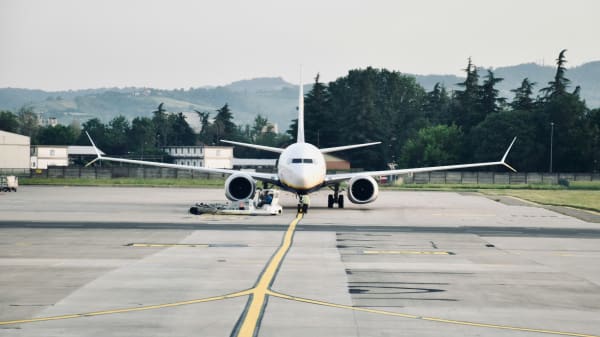
If you're an aviation fanatic with dreams of journeying around the globe while making a promising career, the world of chartered flight careers is just the adventure you're looking for. This sector of aviation offers a rich diversity of opportunities in both flight and ground roles, promising a career that is fulfilling, financially rewarding, and abuzz with excitement.
Whether you’re a young adult making a career selection, a professional pursuing a shift in aviation, or a flying enthusiast curious about careers in this sphere, this article dives deep into the exciting world of chartered flight careers.
Position Roles in Chartered Flight Careers
Chartered flight careers come with various positions, each with its unique set of responsibilities and prerequisites. Here's a low-down on some notable roles in this sector:
- Pilots : A chartered flight pilot is the primary role many think of when discussing this career. Pilots are in charge of navigating the jet safely. A pilot requires substantial training, typically acquiring a bachelor's degree in aviation, experience hours of flying, and completion of pilot training programs.
- Flight Attendants/Cabin Crew : This position ensures passenger safety and comfort during the flight. The role requires exceptional customer service skills, communication skills, and emergency protocol awareness.
- Air Traffic Controllers : This ground role is crucial for safe take-offs and landings, effectively communicating weather reports, flight route instructions, and other essential information.
- Aircraft Mechanics/Technicians : Those in this role handle aircraft inspections and maintenance, ensuring optimal condition before landing and take-off.
- Flight Dispatchers : They plan flight schedules, track aircraft in flight, give route instructions to pilots, and issue warnings about weather conditions. They work closely with pilots to make crucial decisions.
What makes Chartered Flight Careers Rewarding?
There are countless reasons why those interested in the aviation industry choose to pursue chartered flight careers. Here are a few:
- Globetrotting : For those who dream of traveling the globe, these roles are a chance to explore different parts of the world while working.
- Competitive Salaries : Generally, these careers offer decent compensation, which, with experience and exposure, can increase significantly. Depending on the role, one might also get additional benefits like flying allowances or travel discounts.
- Exciting Work Environment : Each day brings a new experience in the aviation industry. Whether catering to VIP clients, navigating unique routes, or dealing with unpredictable elements, boredom is a rarity here!
- Networking Opportunities : Working in chartered flights allows you to meet and network with people from across the world and various walks of life. This diversity can be a booster for personal growth and future opportunities.
Skillsets and Educational Requirements
Chartered flight careers are fulfilling, but they also require certain skillsets and educational qualifications. Here are some necessary components:
- Education : Many flight careers require at least a bachelor’s degree in aviation or related fields. For pilots, FAA-certified training programs and a substantial number of flight hours are essential.
- Certifications and Licenses : Depending on the role, certain certifications and licenses might be necessary. For instance, flight attendants often need a FAA Certification of Demonstrated Proficiency, pilots require a commercial pilot’s license, and aircraft mechanics need an FAA mechanic’s certificate.
- Physical and Mental Health : Most roles require individuals to be in excellent health. For pilots, this includes clear vision, excellent hearing, and overall physical fitness. Strong mental health and stress management skills are also vital given the demands of the job.
- Soft Skills : High levels of communication, problem-solving skills, attention to detail, and being able to make quick decisions in stressful situations are some of the soft skills immensely beneficial in these careers.
Challenges and Mitigations
While chartered flight careers come with many perks, they also pose certain challenges. Understanding these and being prepared can help in making a well-informed decision:
- Irregular Work Schedules : This industry often requires working long hours, weekends, holidays, and sometimes at short notice. Time management and lifestyle adaptability are key.
- Job Stress : The responsibility of passenger safety, dealing with unexpected weather, or technical issues can cause stress. Regular stress management techniques can be beneficial.
- Physical Demands : Long hours of standing, heavy lifting (for flight attendants and technicians), or sitting at the control panel can be taxing on one's health. Regular exercise and a healthy lifestyle can help manage these demands.
The Future of Chartered Flight Careers
The future seems bright for chartered flight careers. Studies suggest a steady growth in air travel in the years to come. The projected increase in job opportunities for roles such as commercial pilots, flight attendants, and air traffic controllers extolls the potential of this sector.
Ultimately, a career in chartered flights is not just about globetrotting and lucrative paychecks. It’s about the thrill of soaring skies, navigating foreign territories, knowing the dynamics of an aircraft, and a shared commitment to getting passengers safely to their destinations. So, buckle up and embark on this exciting career journey that promises growth, learning, and an adventure of a lifetime!
Enjoy what you’ve read? Let others know!
Recommended Articles

Building a Strong Online Presence for Aviation Careers
September 13, 2024
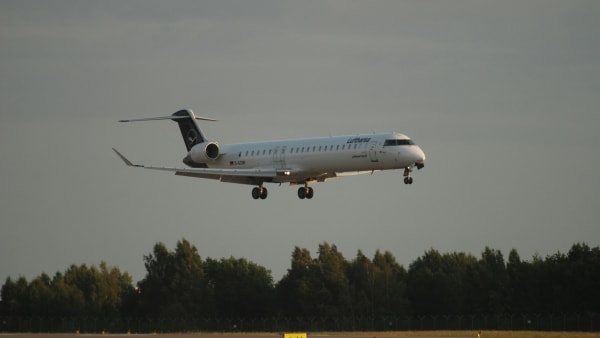
The Role of Social Media in Aviation Careers
September 11, 2024

The Role of Simulators in Aviation Training Programs
September 06, 2024

Navigating the Ethics of Autonomous Flight
September 04, 2024
- Subscribe Now Opens in new window
- Air Force Times Opens in new window
- Army Times Opens in new window
- Marine Corps Times Opens in new window
- Pentagon & Congress
- Defense News Opens in new window
- Flashpoints
- Benefits Guide Opens in new window
- Military Pay Center
- Military Retirement
- Military Benefits
- VA Loan Center Opens in new window
- Discount Depot
- GearScout Opens in new window
- Military Culture
- Military Fitness
- Military Movies & Video Games
- Military Sports
- Transition Guide Opens in new window
- Pay It Forward Opens in new window
- Military History
- Black Military History Opens in new window
- Congressional Veterans Caucus Opens in new window
- Military Appreciation Month Opens in new window
- Vietnam Vets & Rolling Thunder Opens in new window
- Hall of Valor Opens in new window
- Service Members of the Year Opens in new window
- Create an Obituary Opens in new window
- Medals & Misfires
- Installation Guide Opens in new window
- Battle Bracket
- CFC Givers Guide
- Task Force Violent
- Newsletters Opens in new window
- Early Bird Brief
- Photo Galleries
- Long-Term Care Partners
- Navy Federal
- Digital Edition Opens in new window
Globetrotting Leviathan: Graf Zeppelin’s amazing voyage
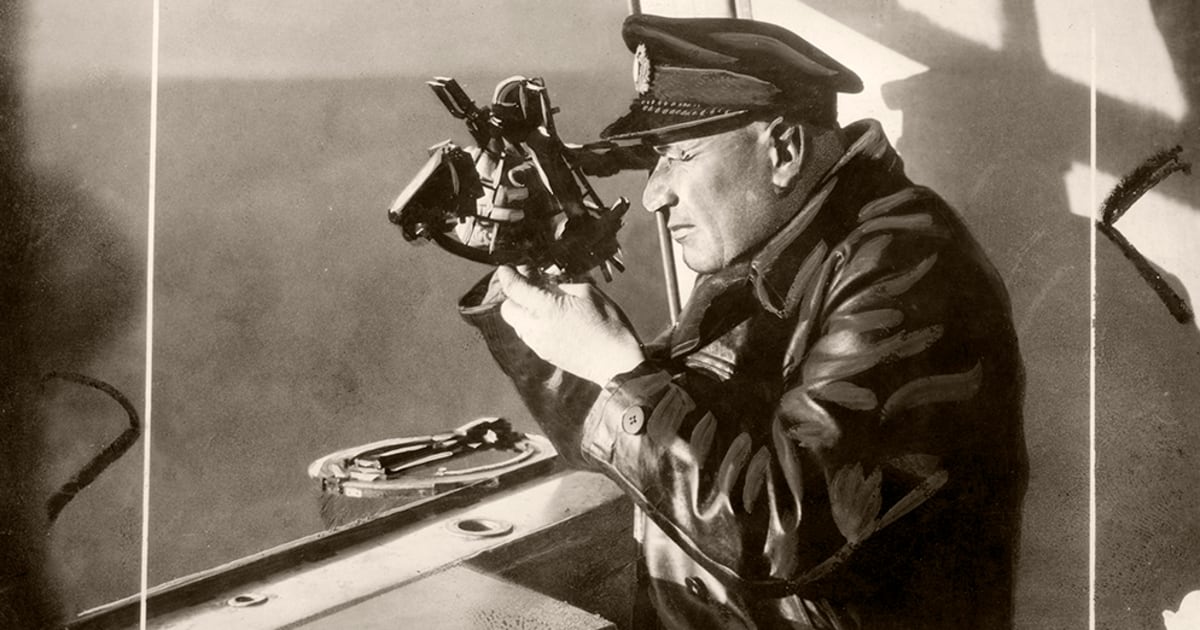
It was August 1929, but the tiny Russian hamlet of Verkne Imbatskoye moved to the rhythms of another century.
A cluster of thatch-roofed log cabins, the town clung to the banks of the great Yenisei River in Siberia. Cocooned from the outside world by thousands of square miles of dense forest and marsh, Imbatskoye scratched a bare living from its surroundings. Horse-drawn carts rumbled along dirt paths, and smock-clad peasants greeted each other as they passed by. It was an ordinary day, timeless in its routine, but the 20th century was about to intrude in a big way.
An unfamiliar noise filled the air, a kind of rumbling moan that drowned out the normal barnyard chatter of domestic animals. Then, all at once, the villagers saw it — a great silver monster looming over the horizon, heading straight for the defenseless scattering of cabins.
The aerial beast was as big as a mountain, its shadow so huge the village could be eclipsed into a momentary “night.”
For all is mammoth bulk, the creature floated easily in the sky and seemed to be moving under its own power. Was this a sign of Armageddon? A judgment on Stalin and the godless Communists ruling in Moscow? Or heaven’s punishment on the villagers for their own sins?
Panic gripped Imbatskoye like the icy hand of doom. Peasants rushed into their houses and barred the doors; others, rooted in sheer terror, gazed transfixed in horrified awe. Even the animals were panic-stricken; a horse galloped wildly though the dirt streets, harnessed to a cart that smashed into two cabins and demolished them.
The great silver object was neither an extraterrestrial visitation nor a supernatural sign, but the Luftschiff (airship) Graf Zeppelin , a passenger dirigible on an around-the-world journey.
The 775-foot-long, cigar-shaped craft was looking for a landmark as a navigational “fix,” and tiny Imbatskoye provided that information.
Graf Zeppelin glided on eastward, leaving behind a hamlet that would never forget its rude visitation.
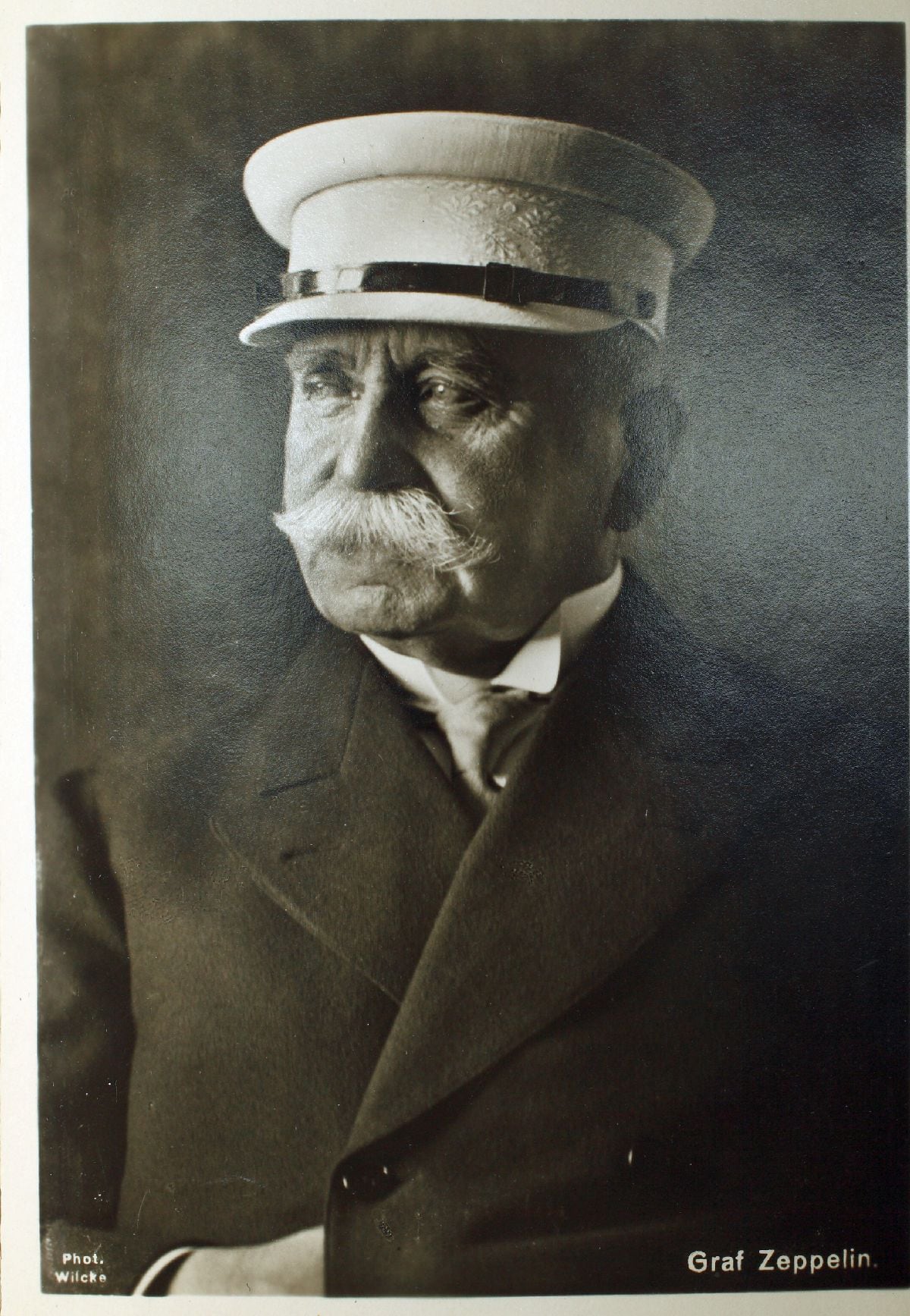
The airship Graf Zeppelin was named in honor of Graf (Count) Ferdinand von Zeppelin, father of commercial dirigible aviation.
In a sense, Graf Zeppelin ‘s world-circling tour began in 1900, when the count first experimented with airships. Zeppelin’s great idea was to produce rigid airships, not merely gas-filled balloons.
According to this plan, the airship envelope was held firmly in shape not by internal gas pressure, but by a rigid metal skeleton. The lifting gas — hydrogen, in this case — would be housed in a series of self-contained cells within the metal skeleton’s “ribcage.”
By 1914, the count’s airships — nicknamed Zeppelins after the grand old man himself — were a moderate success, carrying fare-paying passengers throughout Germany. When World War I broke out, the Zeppelins were converted to military use, chiefly bombing England.
The Zeppelin raids did some damage, but their main effect was psychological. After the first shocks, the British learned that these sausage-shaped monsters were slow and vulnerable. Incendiary bullets were developed that turned the hydrogen-filled German raiders into flaming coffins.
When Germany surrendered in 1918, its airship industry was in ruins.
Count Zeppelin had died in 1917 at the age of 79, but he had a worthy successor in Dr. Hugo Eckener .
Eckener had been with the Zeppelin company for years, working his way up from publicist and aide to operational chief in 1922. The torch had been passed to able hands, but Eckener had to keep the light alive in the dampening rain of Allied restrictions, lack of funds and public indifference.
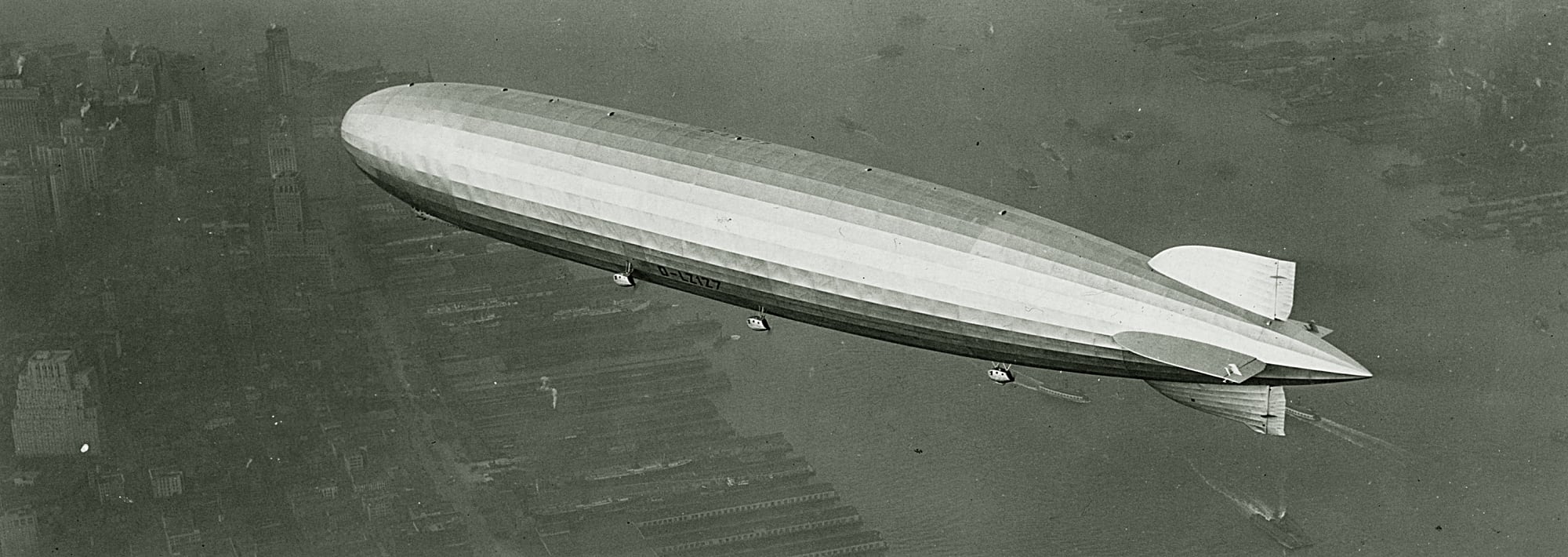
The allies had imposed harsh terms on a vanquished Germany, and the airship industry suffered with the rest of the country. All remaining Zeppelins were confiscated by the Allies, and severe restrictions were imposed on building others. Military Zeppelins were completely forbidden, and commercial ones were to have a maximum gas capacity of 1 million cubic feet — far too small for the long-distance dirigibles Eckener had in mind.
To help the Zeppelin company survive the lean times, Eckener converted its metal-making facilities to produce household kitchen utensils. Gradually, the political climate changed for the better, and the harsh restrictions were lifted in 1926. Eckener gratefully switched from making pots and pans to building airships.
But financial troubles still loomed. The German economy was still recuperating from the terrible inflation of 1923, when it took more than 4 trillion marks to equal one U.S. dollar. Times were better, but in 1926 neither the German Weimar Republic nor the Zeppelin company had the funds for a major airship project.
Ever resourceful, Eckener turned to the German public and launched a direct subscription appeal. After touring throughout the fatherland, the Zeppelin chief raised 2.5 million marks — far short of the goal, but enough to start. Eventually the German government pitched in and made up the balance.
With the necessary funds in hand, work began immediately on the new airship. Months later, on July 8, 1928, Countess Helga von Brandenstein-Zeppelin smashed a bottle of champagne across the bow of the newly completed dirigible and christened it Graf Zeppelin in honor of her late father. Graf Zeppelin ‘s official designation was LZ.127, but soon everyone affectionately called it simply Graf .

Everything about Graf was monumental; in fact, it was the largest dirigible yet seen. Designed by longtime Zeppelin architect Ludwig Durr, its gigantic bulk measured 775 feet from nose to tail, with a girth of 3.7 million cubic feet. That translated into an airship that was 10 stories high and more than two city blocks long.
Critics maintained that Graf was too slender, too “skinny” for peak aero-dynamic efficiency, saying a stouter shape would have permitted a smoother air flow.
No matter; a worshipping public loved the ship as it was. Looking something like a giant silver torpedo, Graf ‘s outer skin was made of heavy-duty cotton, stretched so taut that the revealed outlines of its metal skeleton produced a fluted design effect on its body.
The airship’s skeleton was composed of a series of main and secondary rings, braced to the ship’s keel and linked together by longitudinal girders. The main rings were made up of diamond-shaped trusses. The rings and girders were made of a light aluminum and copper alloy called duralumin.
Duralumin was as strong as steel yet only one-third as heavy; even so, Graf contained 33 tons of this metal.
There were 17 gas cells within the mighty airship, held rigidly in place by a spider’s web tracery of rings, girders and bracing. The gas cells were made of cotton fabric, each with an airtight lining of membranes from the intestines of oxen. It took some 50,000 membranes to line just one gas cell, and the cost was enormous.
The upper cells held hydrogen for lift, the lower cells a gaseous fuel similar to propane, called blau gas.
The lighter-than-air hydrogen provided buoyancy, and forward propulsion was supplied by five Maybach VL-II engines, each mounted externally in its own gondola. Their twin-bladed — later four-bladed — propellers were mounted pusher-style, and the engine nacelles were big enough for a man to crawl inside and perform in-flight maintenance.
A tear-shaped gondola was mounted forward, a small “mole” on the ship’s nose that did little to break its smooth, clean lines. Measuring 98 l/2 feet long by 20 feet wide, this passenger gondola housed the control car, galley, chart room, radio room, dining room and a double row of 10 sleeping cabins. Washrooms and toilets were behind the sleeping cabins.
Unseen by passengers, Graf ‘s keel inside the envelope was honeycombed with other rooms: crew “bunkhouse,” generator room, cargo rooms and others.
Graf Zeppelin was not only an airship but also a work of art. Aesthetics and aerodynamics seemed to meet in its graceful form.
Its cotton skin was protected by no fewer than six layers of paint and dope. The paint was silver, the better to reflect the sun’s rays and thus reduce the heat inflation of the hydrogen. As an added touch, the painted surface was sandpapered smooth, leaving a “sculptured” sheen that offered little wind resistance.
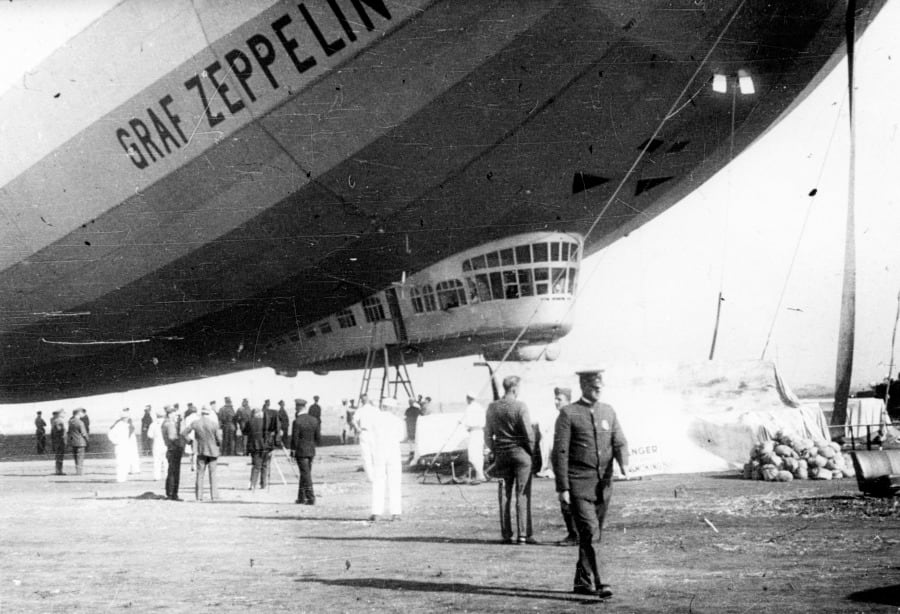
After a few shakedown flights, Graf departed on its maiden voyage to America in October 1928.
Ironically, the giant airship’s first major flight was almost her last. At first all was quite routine, except that certain items like bottled water were running out. Just south of the Azores, in mid-Atlantic, the passengers were just sitting down to a sumptuous breakfast when an ominous wall of clouds appeared on the horizon.
These swirling, blue-black masses slammed into Graf Zeppelin , causing its nose to dip sharply down before rising upward at a 15-degree angle.
Nature had literally turned the tables on the passengers, as furniture was upset and people slid to the floor. Terrified passengers fell on each other in an avalanche of crashing plates, saucers and food. The battered voyagers were festooned with sausages and splattered with gobs of butter and marmalade, but it was Eckener who had egg on his face — he had to right the ship at once.
When Graf was literally on an even keel again and the immediate crisis had passed, the passengers could congratulate themselves on their survival. But such backslapping was premature — Graf had sustained serious structural damage.
The violent turbulence had shredded the port stabilizing fin; worse, ripped pieces of fabric floated outward like streamers, threatening to jam the rudders and elevators.
After ordering the ship to slow to half-speed, Eckener called for volunteers to repair the damage. It was a dangerous assignment; the volunteers would have to crawl out onto the damaged stabilizer, clinging to its exposed girders while being buffeted by howling winds.
Nevertheless, four crew members — including Eckener’s own son Knut — went out and repaired the damage. The fabric “streamers” were cut away and the frayed edges of the break lashed down.
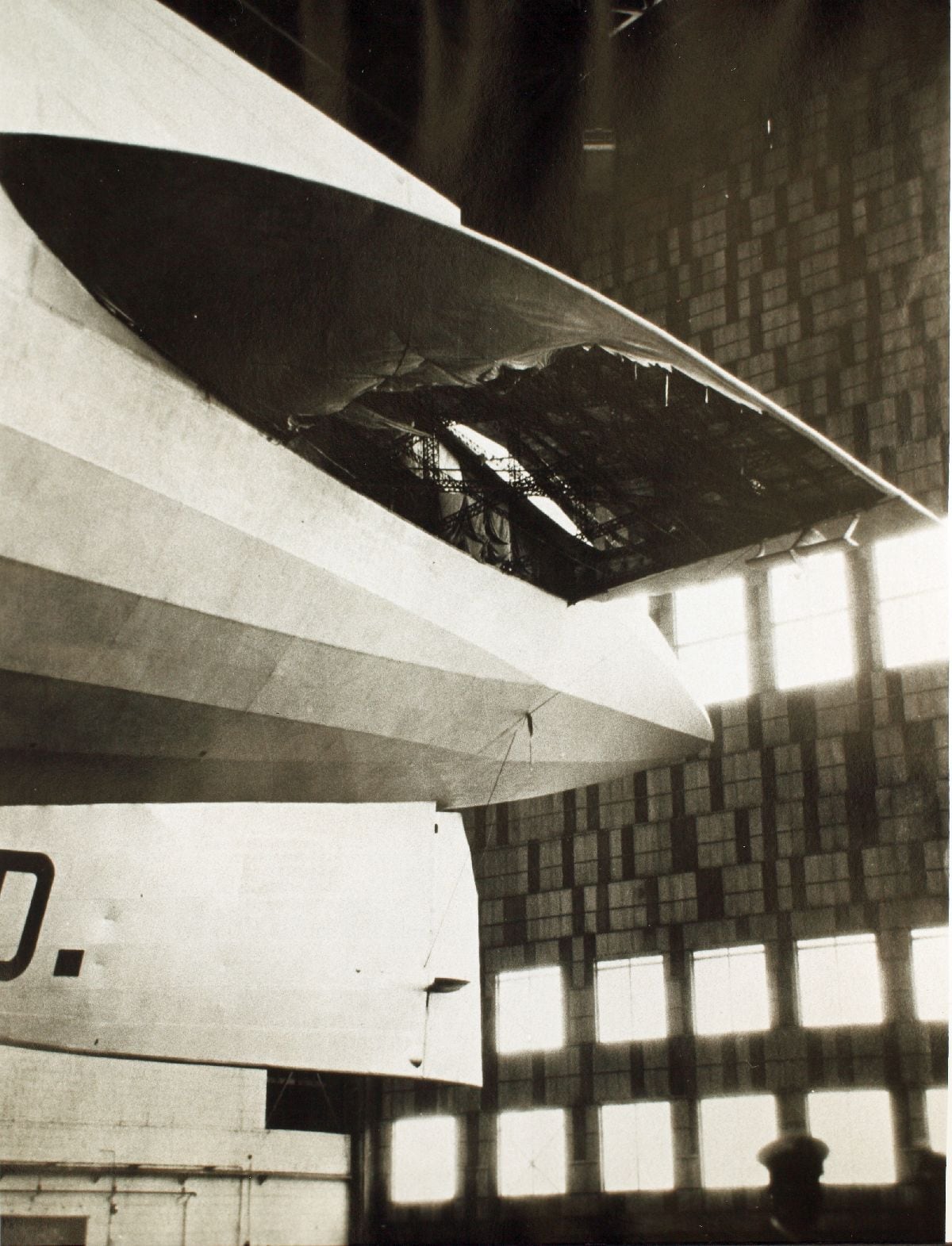
Graf Zeppelin completed its inaugural journey to America and conducted a triumphal tour of Washington, Baltimore and New York City.
Its fame grew until the silver colossus became a legend in its own time and half the world seemed gripped by “Zeppelin fever.”
To keep the publicity mills turning, Eckener undertook a series of demonstration flights around Europe and the Mediterranean. Word spread that a voyage on Graf was a marvelous experience, with breathtaking scenery and first-class service.
But to Eckener, Graf Zeppelin was literally a trial balloon.
Although he was not in favor of building more giant airships until public response showed there was a need for them, the good doctor was wise enough — and showman enough — to create that demand by keeping his airship in the public eye via spectacular stunts.
The public’s growing affection for Graf was a positive sign but the jury was still out on the future of airship travel.
Eckener decided to pull out all the stops; he would take Graf Zeppelin on an around-the-world cruise, something no commercial aircraft had ever attempted.
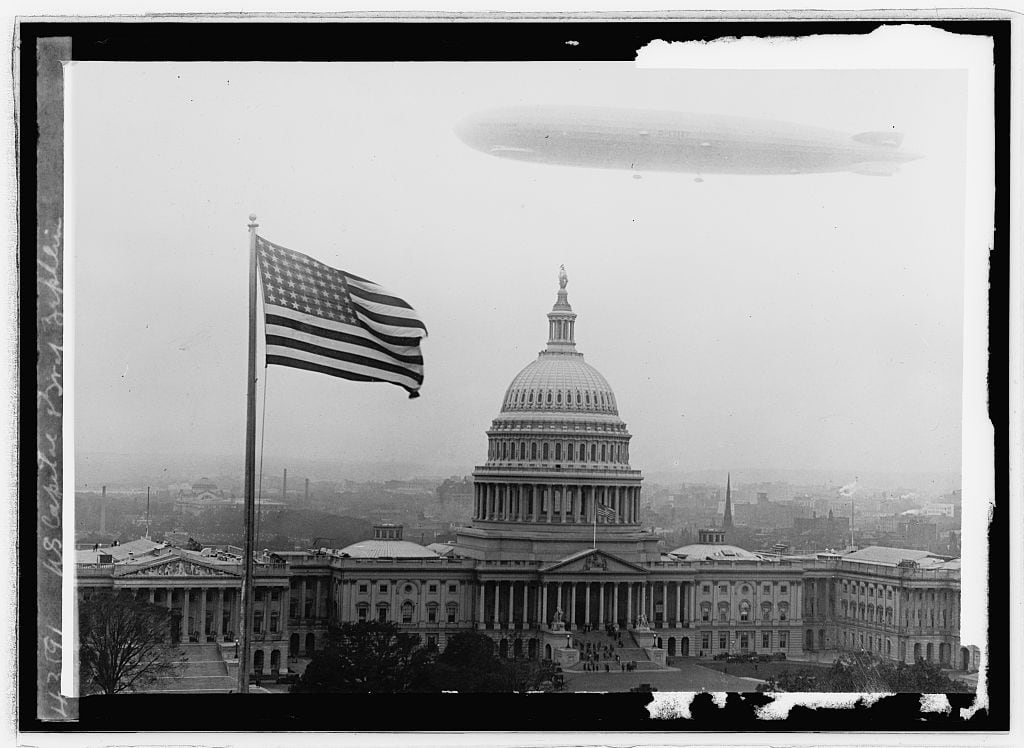
Although he was rich in dreams, Eckener was poor in cash and needed financial backing for his proposed globe-girdling jaunt.
American newspaper magnate William Randolph Hearst stepped forward and offered to bankroll the project to the tune of $100,000.
No serious strings were attached, but Hearst did insist on exclusive story rights, and that the journey begin and end on U.S. soil.
Eckener accepted, so the start and finish point of the tour would be the Naval Air Station at Lakehurst, New Jersey.
It was then a matter of selecting the route. To begin with, Graf Zeppelin was going to circle the earth from west to east, with the first leg from the United States back to the Zeppelin base at Friedrichshafen.
Where next? The only suitable dirigible hangar in the entire Far East was located at the Japanese naval base at Kasumiga-ura, so Japan was an obvious port of call. Some consideration was given to flying east via the Mediterranean, the Indian Ocean and the China Sea, but that route was rejected because it was too long.
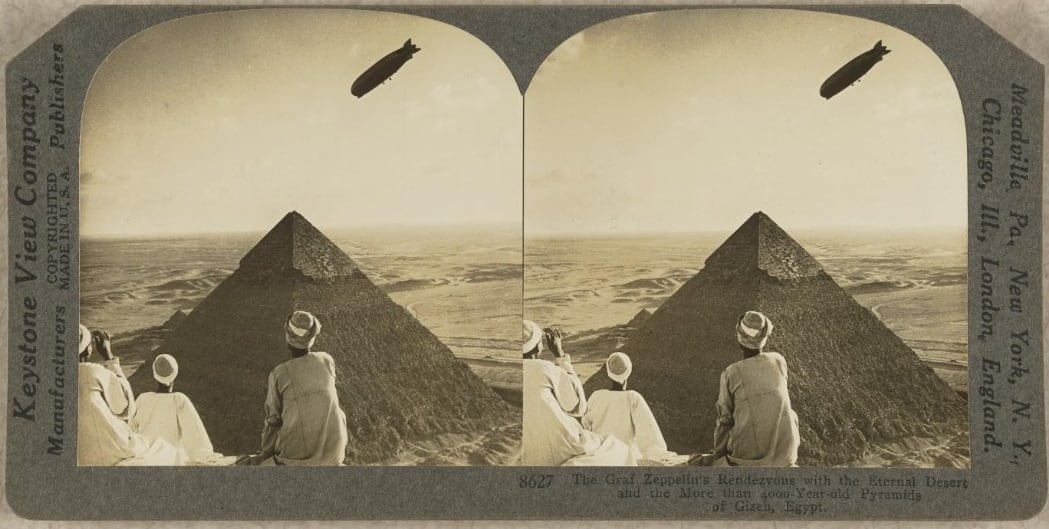
Poring over maps and charts, Eckener decided on a far northerly course, one that would take Graf over Russian Siberia to Yakutsk, thence to the Sea of Okhotsk and Japan.
After Japan, the airship would strike east across the Pacific to California, then on to its starting point at Lakehurst.
When preparations were complete, Graf Zeppelin departed Friedrichshafen on Aug. 1, 1929, bound for its official, Lakehurst world cruise starting point.
Additional revenue was provided by the sale of thousands of commemorative postage stamps.
Indeed, Graf carried mail on this Atlantic run, and collectors were later thrilled to receive letters with its distinctive cancellation mark, a blue ink stamp with a logo showing the Zeppelin floating over the New York skyline, and bearing the legend “Luftschiff Graf Zeppelin — Amerikafahrt 1929.”
Graf Zeppelin departed from Lakehurst on its epoch-making global journey on Aug. 7, 1929, while a brass band serenaded the airship with the all-too-appropriate tune “There’s a Long, Long Trail.”
The Lakehurst-Friedrichshafen hop was uneventful and took some five hours. Once back in Germany, there was a five-day layover while the ship’s engines were thoroughly checked. They had to be; the most perilous leg of the journey lay just ahead, a 6,800-mile nonstop flight to Tokyo.
There were 20 passengers aboard, an international mix that included Japanese, Americans, British, a Spaniard and, of course, Germans.
One of the Americans was Lt. Cmdr. Charles Emery Rosendahl, the U.S. Navy’s top airship man. Britain and its Commonwealth were represented by arctic explorer Sir Hubert Wilkins and Lady Drummond Hay. Besides being a Hearst journalist, Lady Hay was the only woman aboard.
There were also representatives from destination countries, including a Comrade Karklin of the Soviet Union. Karklin was on board as the official representative of the Soviet government, there to watchdog the operation when Graf flew over Russian territory.
The rest of the passenger roster was made up of reporters and well-heeled private passengers, some of whom paid as much as $9,000 for a ticket on this historic flight. Competition was fierce, and apparently Graf was slightly overbooked. Some paying passengers were left behind because of weight considerations.
When Graf left Friedrichshafen in the early hours of Aug. 15, the passengers knew that the next time they set foot on solid ground it would be Japanese soil. The silvery colossus nosed northeastward, past Ulm, Nuremberg and Leipzig while reporters filed stories and passengers amused themselves.
An American put on a phonograph record in the dining room, causing an otherwise staid Japanese reporter to dance a wild Charleston.
A few hours later, at about 10:30 a.m., Graf reached Berlin. The German capital was magnificent from an altitude of 750 feet, with the Spree River winding ribbon-like through the city of stately buildings and broad avenues. The streets were already thick with people, all gazing heavenward, and more poured out of the buildings as Graf floated past.
As the mighty airship soared over the Brandenburg Gate and swept up the Unter den Linden past the Alexanderplatz, the drone of its engines could not muffle the cheers of the assembled thousands below.
Leaving Berlin in its wake, Graf Zeppelin continued eastward, first to Danzig (now Gdansk), and on to Lithuania.

As soon as the Russian border was crossed, Comrade Karklin appeared in the control car to “advise” Eckener on where the airship could and could not go. As it was, Eckener had gone through protracted negotiations to obtain Russian permission for this flight; now he had to put up with Karklin’s carping.
Hoping to score a propaganda coup, Karklin insisted that Graf Zeppelin visit Moscow, where he claimed “thousands” were awaiting the arrival of the mammoth airship. (Western reporters in Moscow reported no unusual activity; no crowds, no Zeppelin fever of any kind.)
Eckener considered Karklin’s “request” but rejected it on meteorological grounds. A low-pressure area over the Caspian Sea was creating contrary east winds over the Russian capital, and Eckener wanted to take advantage of a west wind farther to the north.
Karklin was not pleased by the doctor’s decision, but there was little the Bolshevik could do except jump ship — and it was a long way down. Lacking a parachute, he stayed aboard, a sour Communist presence amid capitalist luxury.
Graf journeyed on, spinning propellers boring into the air, until Vologda came into view. As the dirigible grew nearer, this ancient Muscovite town seemed like an Arabian Nights dream, its golden, onion-shaped church domes sparkling like a chest of jewels.
The airship crossed the Ural Mountains just north of Perm and entered Asia. For the next few days, Graf would travel through Siberia, fabled land of exiles, a region so vast that parts of it were still uncharted. As human habitation grew scarce, navigation would be by dead reckoning, just as in an ocean voyage.
The land below was the Siberian taiga, a vast forested wilderness larger than the continental United States. There was an eternity of trees, a green mantle that stretched hundreds of miles, its immensity broken only by marshes and a few meandering rivers. Vast stands of fir and spruce poked up, giving the emerald carpet a spikey texture, and below their sheltering limbs lurked bear and elk and other wild creatures.
The contrast could not have been more striking: Passengers would gather at the lounge/dining room to feast on fine food and choice wines in an atmosphere of refined elegance. The menu featured such things as pate de foie gras, lamb chops and caviar, all served on fine Bavarian china bearing the Zeppelin logo. In these regions, the passenger gondola was literally an island in the sky, a tiny bit of civilization hung suspended between heaven and earth.
If Graf suffered an accident and went down here, impaled on the fir trees’ spikes, the voyagers had little hope of rescue. Their lives literally depended on Eckener and his airship.
Eventually the Siberian terrain grew monotonous, although there was a momentary spectacle when a huge forest fire was spotted. Black coils of smoke marked the fire’s progress, and many acres were consumed, but in truth such conflagrations were fairly commonplace in Siberia.
This far north, the sun barely disappeared at night, but left a telltale pink smear on the horizon that seemed to anticipate dawn. It was cold, too, and passenger cabins were unheated. When the voyagers assembled for breakfast some mornings, they looked more like skiers than airship travelers, bundled up in camel-hair coats, sweaters and other wintery garments.
After reaching the Yenisei River basin and making that navigational fix on the startled village of Imbatskoye, Graf roared onward toward the Tunguska region. Eckener was hoping to find a crater left by the celebrated Tunguska Event 21 years before.
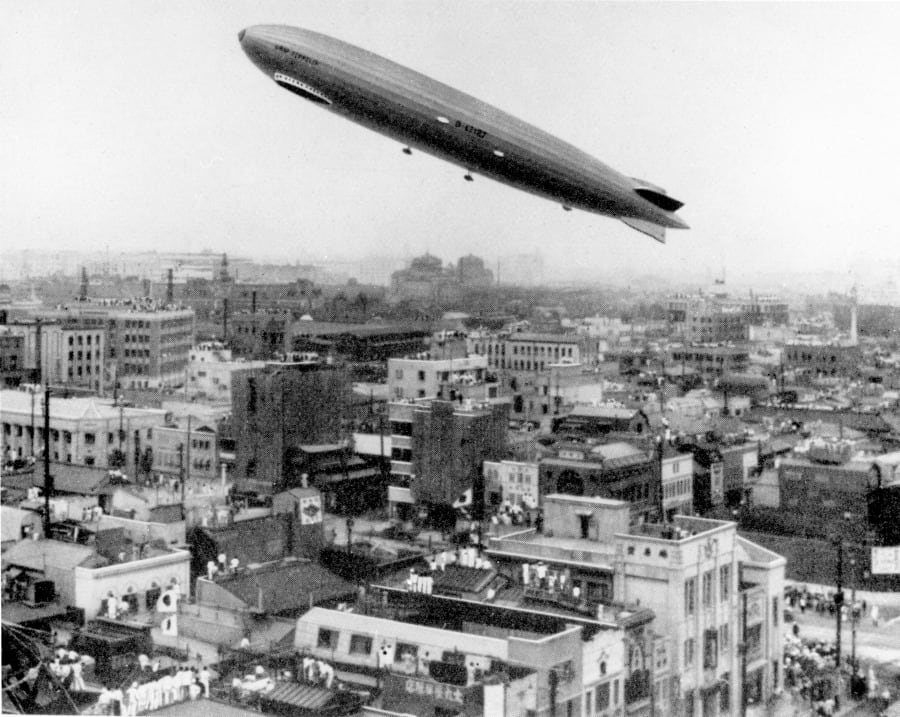
On June 20, 1908, an enormous explosion had rocked this part of Siberia, so powerful that every tree within 20 miles was knocked flat. Shock waves from the blast knocked horses off their feet 100 miles away, and some house roofs were destroyed. It was similar to a high-altitude hydrogen bomb detonation, and has long been a mystery. In the 1920s, most scientists felt it had been a meteor, and so should have left a telltale crater.
Graf Zeppelin searched in vain for the crater and eventually had to move on. Today scientists speculate that the cause was a piece of comet, a “dirty snowball” of water and gases that exploded and vaporized on entering the earth’s atmosphere, and so left no crater. In any case, Graf finally reached Yakutsk, a fur-trading town on the banks of the five-mile-wide Lena River. The next hurdle lay just ahead, the Stanovoy mountain range.
The Stanovoy mountain range was not well known; even its height was a matter of conjecture. The snow-mantled crags were said to be 6,500 feet high, but there was also a 5,000-foot pass that led through the mountains. Eckener poked Graf ‘s snout toward the precipitous granite wall, probing for an opening, and finally found what he though was the mountain pass.
The pass began as a high mountain valley, but it soon turned into a steep-sided canyon. At 5,000 feet, the valley-canyon kept rising, forcing Graf to do the same. The airship climbed higher and higher, its vulnerable fabric belly only a few hundred feet from the sharp crags. Sheer canyon wall encroached as well, rising funnel-like to within 250 feet of the struggling dirigible.
At 6,000 feet, with Graf Zeppelin a bare 150 feet above the ground, the mountain chain abruptly fell away. They were through the barrier, and the azure Sea of Okhotsk beckoned beyond. Though he was never one for displays of emotion, Eckener threw out his arms and exulted, “Now that’s airship flying!”
After that harrowing experience, smokers among the passengers must have had an urge to light up — except all smoking was verboten as a fire risk aboard ship.
The lighter-than-air leviathan arrived in Tokyo, Japan, on Aug. 19, 1929. The voyagers were warmly received by the Japanese, although there was nearly a diplomatic incident when Graf sailed over the Imperial Palace, an action that was strictly taboo. The slight was forgiven, so Graf Zeppelin duly landed at Kasumiga-ura Naval Base with the aid of a 500-man Japanese ground crew.
The next few days were a whirl of teas, parades and celebrations as the Japanese vied with each other to do honor to the airship argonauts. Although outwardly gracious, Eckener was out of sorts; Japanese food did not agree with him, he had a boil and he was nearly suffocating in the August heat.
And when it was finally time to leave, the Japanese ground crew damaged one of the gondolas.
Repairs were effected at once, and Graf was soon on its way. However, 18 members of the Japanese ground crew were so ashamed that they pledged to commit suicide if the airship did not successfully complete its journey.
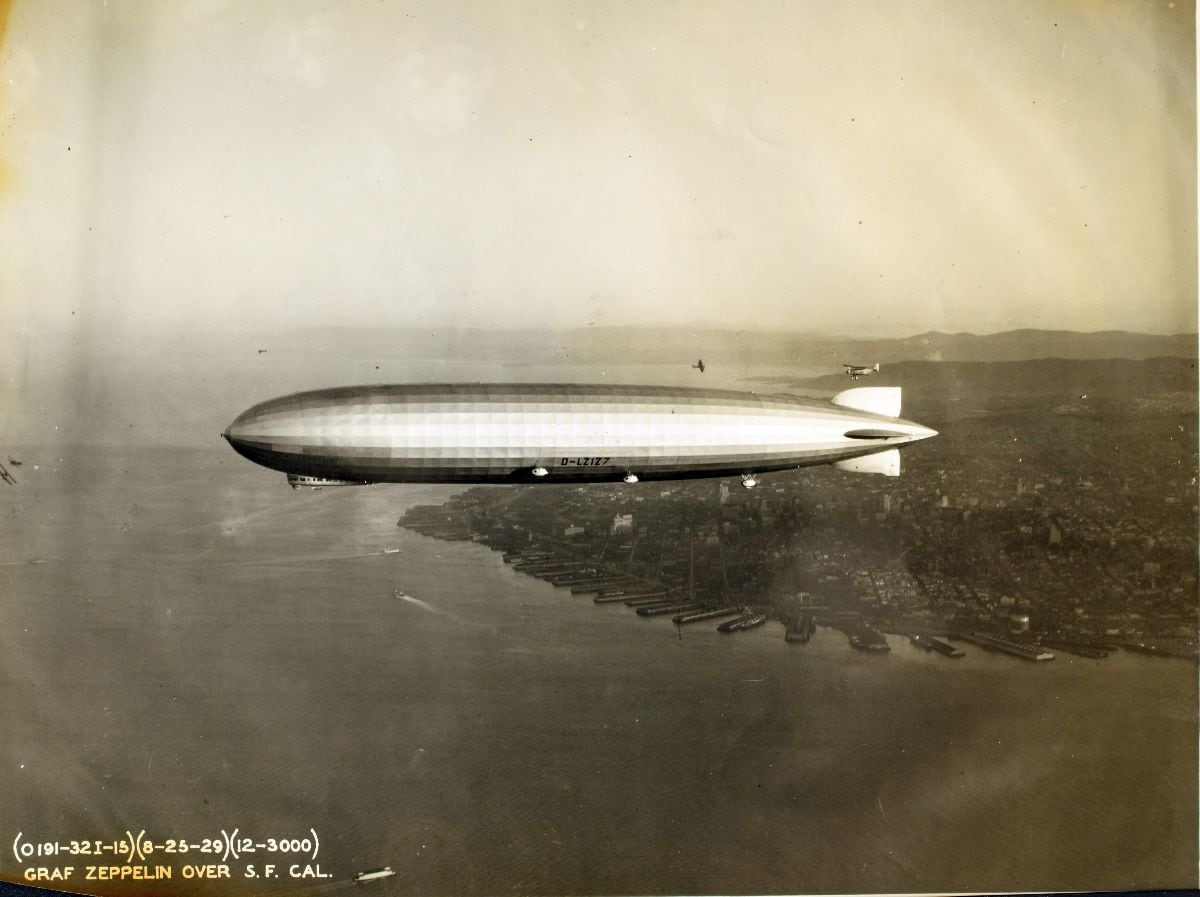
The Pacific crossing was largely uneventful.
Gossamer cloud wisps floated past Graf as it raced along at around 70 mph, their cottony fingers caressing her sleek sides. At one point, the Zeppelin took advantage of the south-side fringe of a typhoon, which boosted its speed to a temporary 98 mph.
But most of the time clouds obscured the view, and the trip was so smooth the passengers almost lapsed into boredom-induced comas.
On Aug. 25, Graf Zeppelin neared the California coast. The great airship’s visit to San Francisco could not have been more dramatic. Emerging from a cloud bank, late afternoon sunlight glinting off her silvery flanks, the airship made quite an impression.
No one could fail to recognize the huge dirigible, because the great red letters “ Graf Zeppelin” were in clear view on the nose. Graf did not need to worry about colliding with the Golden Gate Bridge, because it was as yet unbuilt, but contrary winds forced the airship to enter San Francisco Bay at a crablike sideways angle.
After a few parade passes over San Francisco, much to the delight of Bay Area crowds, Graf headed south to Los Angeles.
When the dirigible moored at Mines Field, it had logged an official trans-Pacific flight time of 79 hours and 3 minutes.
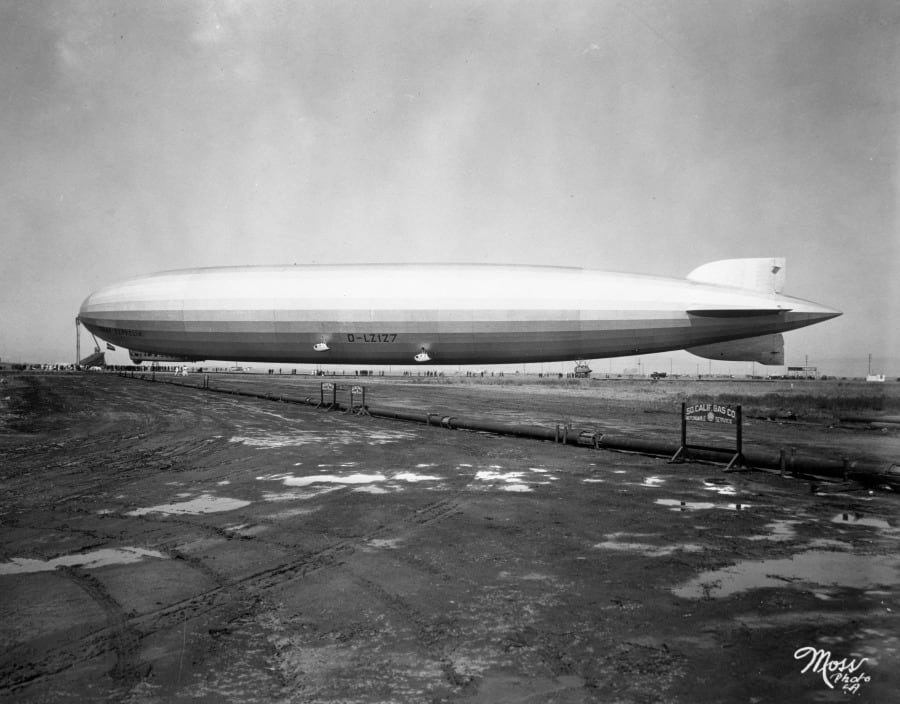
But when the Zeppelin tried to take off in the early morning hours of Aug. 26, a temperature inversion layer held the airship down.
Years later such inversion layers would trap pollution and create smog, but now the Zeppelin was held fast by an invisible roof of warmer and less dense air, hovering just over a ground-hugging cold layer.
Crew members had to lighten ship, so surplus food, furniture and water ballast were unceremoniously dumped.
When takeoff was attempted, Graf rose, but unevenly, causing her tail and stabilizers to furrow the ground. The passenger gondola cleared some nearby power cables, but the dragging tail was on a collision course with them.
“Down elevator!” Eckener cried, and this maneuver lifted the tail enough to clear the cables.
The rest of the journey was more triumphal procession than routine trip. The route took Graf across Arizona and New Mexico, then northeast to Chicago before heading toward the Atlantic seaboard.
When Graf reached New York, it floated over the concrete canyons of Manhattan to the applause and delight of millions.
The American version of the world flight ended when Graf Zeppelin moored at Lakehurst on Aug. 29, 1929, establishing a speed record of 21 days, 7 hours and 34 minutes.
And if various layovers en route are subtracted and only flying time is counted, then the tally stood at 12 days and 11 minutes for circling the globe.
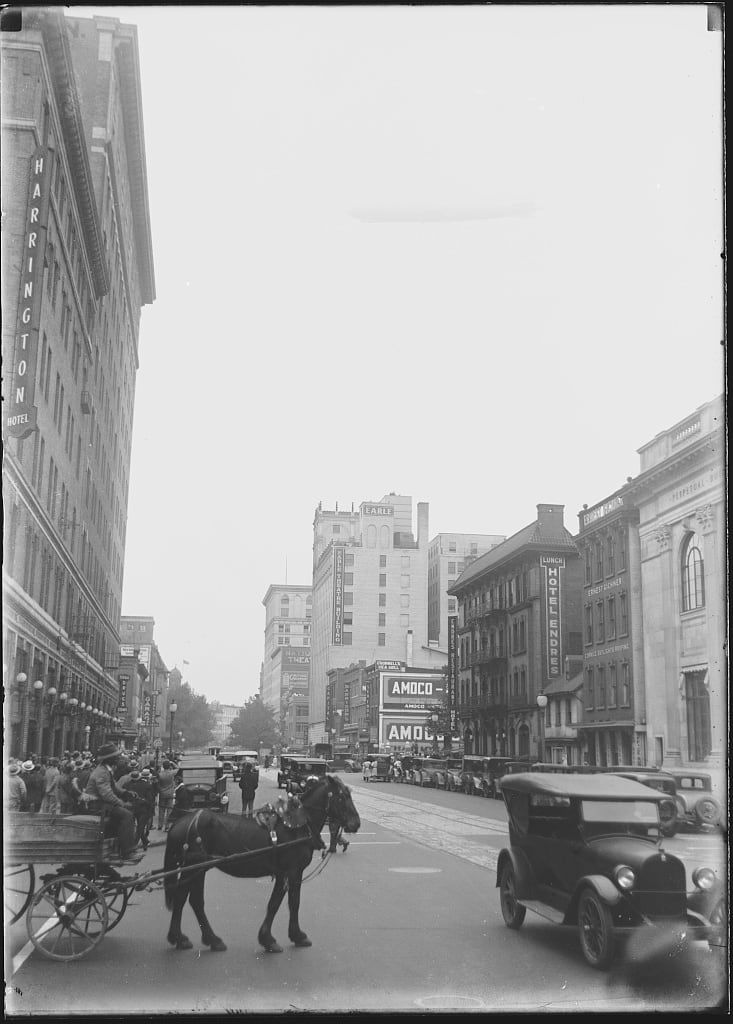
A gratified Eckener was given a ticker-tape parade in New York that rivaled Lindbergh’s two years earlier, and President Herbert Hoover lavishly praised the globe-trotting argonaut, comparing him to Columbus.
Eckener stayed in New York on business, so Graf Zeppelin completed the German version of the world circumnavigation under the command of Captain Ernst Lehmann. When Graf reached home base at Friedrichshafen on Sept. 4, the airship had officially logged 21,200 miles for the whole flight.
There was a comic footnote to the world cruise.
When Graf landed at Lakehurst on Aug. 29, Otto Hillig came forward with a writ of attachment.
Hillig was one of those passenger hopefuls who had been bumped before the flight began, even though he had paid his $9,000 up front. Furious at being left behind, Hillig was determined that the Zeppelin company was going to have to shell out.
A deputy arrived at Lakehurst to serve the writ, but Navy officials explained that to fulfill the letter of the law, the sheriff would have to remove Graf Zeppelin from its hangar. Undaunted, the lawman replied he was determined to seize the airship, even if it meant he would have to “tie it to a tree.”
Eventually, the Zeppelin company posted a $25,000 bond, and Graf was allowed to fly home to Germany. Hillig sued the Zeppelin company for $109,000 for his alleged “chagrin” at being left behind.
The matter was eventually settled out of court.

The epic around-the-world journey was only one facet of Graf Zeppelin ‘s sparkling career.
The most successful commercial airship ever built, it was the first aircraft to fly more than 1 million miles; the official total was 1,060,000. A frequent visitor to North and South America, Graf crossed the Atlantic 144 times and carried some 13,000 passengers in a nine-year career.
Graf Zeppelin was honorably retired in 1937, the same year its sister ship, Hindenburg , caught fire while landing at Lakehurst, with a loss of 36 lives.
By then the Nazis were in power with a Luftwaffe chief, Herman Goring, who had hated airships even before the Hindenburg disaster. In 1940, on Goring’s express orders, Graf Zeppelin was dismantled and its metal used to build a radar tower in the Netherlands.
Graf Zeppelin is no more, but its memory still stands as a symbol of the all-too-brief airship era.
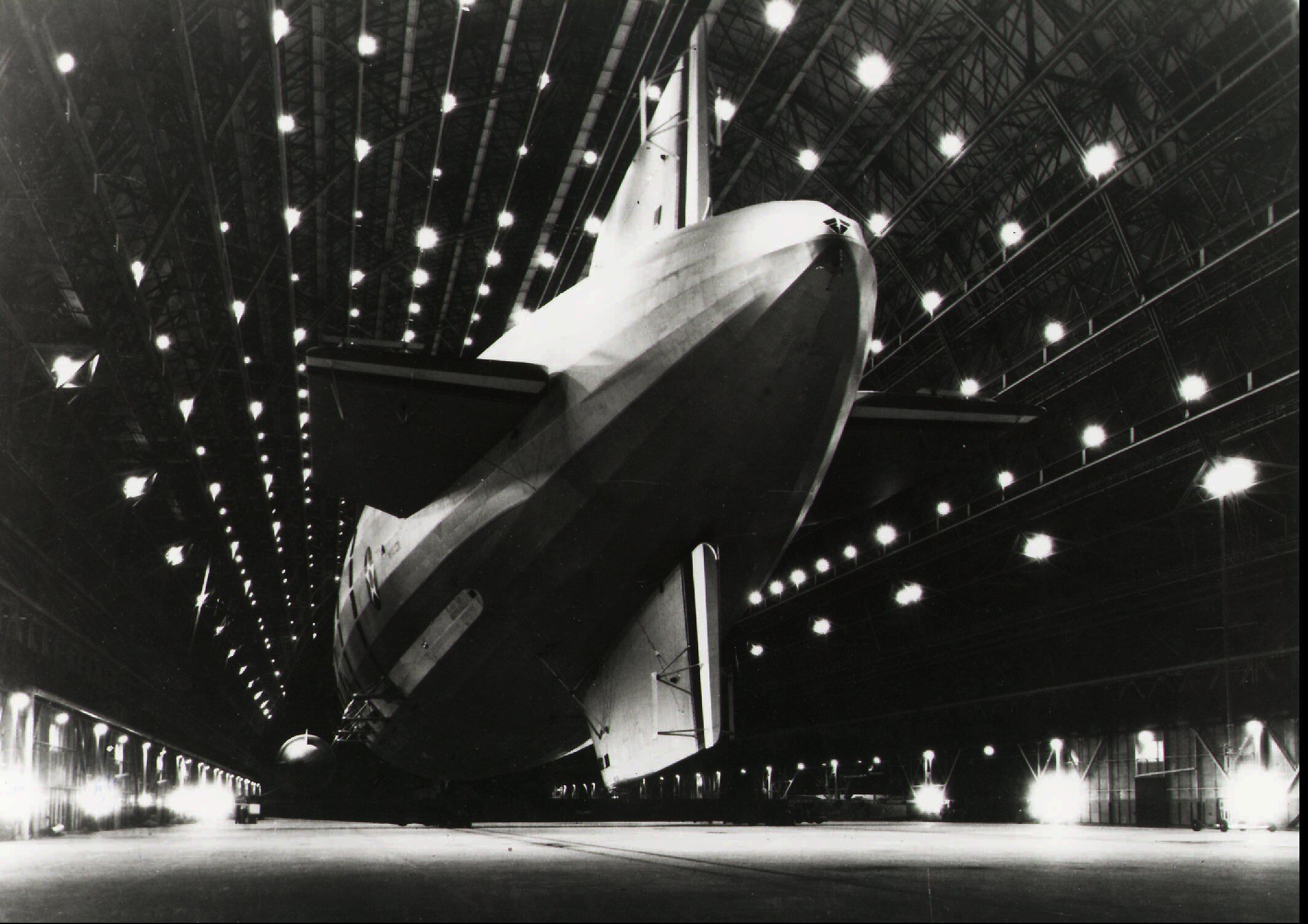
These atomic-powered airships never made it off the drawing board
For the first half of the 20th century, atomic-powered airships were the stuff of science fiction. it wasn’t until president dwight d. eisenhower’s 1953 “atoms for peace” address at the un that the idea received serious attention, but for a variety of reasons they never got off the ground..
This article was written by Eric Niderost and originally published in the July 1993 issue of Aviation History magazine, a sister publication of Navy Times . For more great articles, subscribe to Aviation History magazine today!
In Other News

Navy will force aviators to remain in service to complete sea tours
The navy plans to require its pilots to complete their second at-sea tour before they can get out..

Transportation Command nominee promises review of Gaza pier mission
The three-month effort to deliver aid to gaza included more than 1,000 u.s. servicemembers..
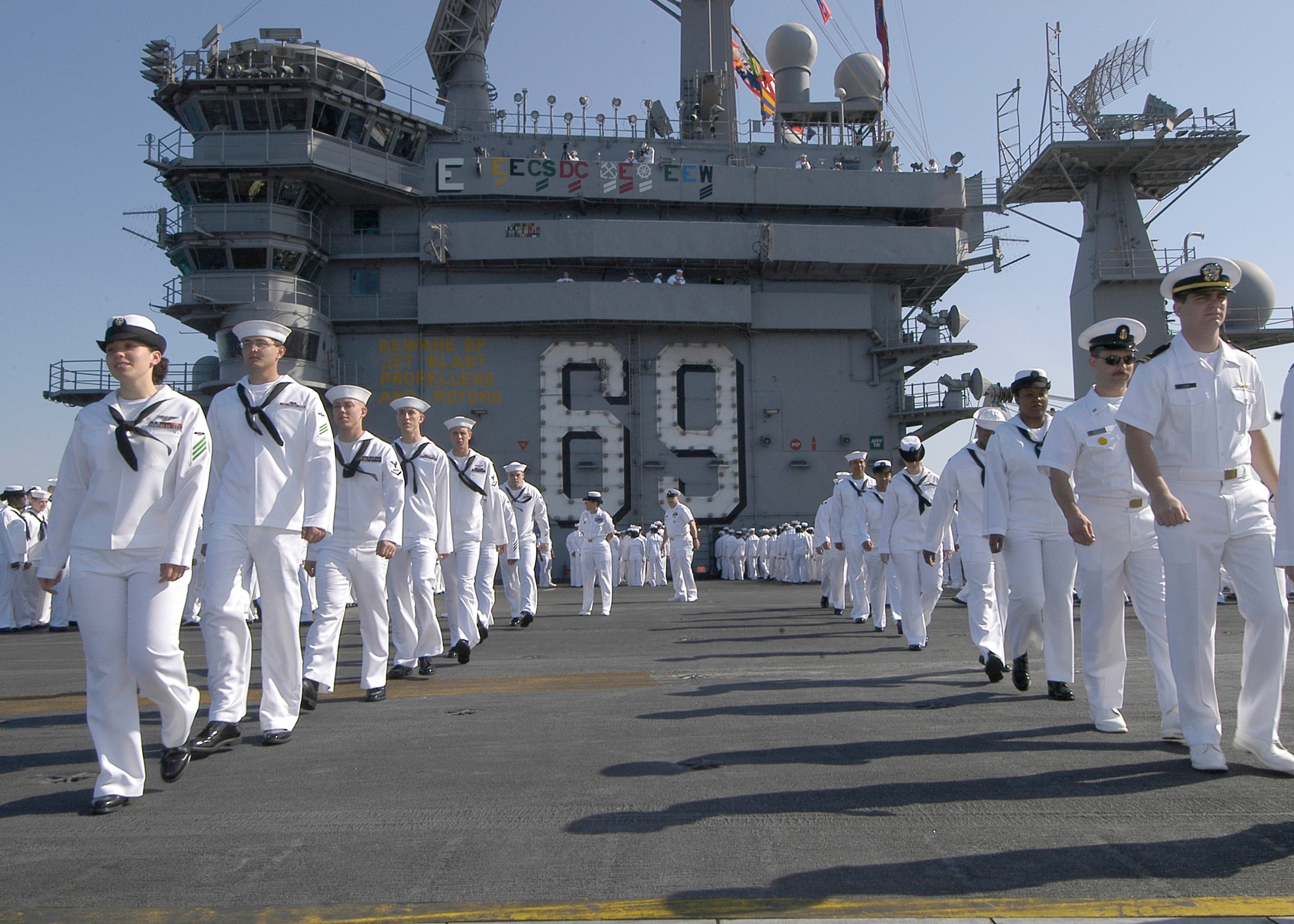
‘We had mission and purpose:’ A chat with the CO of the USS Eisenhower
The commanding officer of the mighty ike aircraft carrier sat down with navy times to discuss the red sea, long deployments and maintaining sailor morale..

Military influencers could help fight disinformation, experts argue
Military influencers could build support for u.s. troops and protect against enemy disinformation attempts to undermine the dod, a rand report says..

This week in Congress: Lawmakers rush to pass VA funding
Defense and veterans hearings on capitol hill for the week of sept. 16, 2024..
- Work With Me
A Family Travel Blog
Home » Travel » Globetrotting Careers: The Perfect Jobs for Travel Lovers
Globetrotting Careers: The Perfect Jobs for Travel Lovers
If you love traveling, you might want to consider these jobs when you plan out your career.
Flight Attendant or Pilot
Digital nomad, travel nursing, from one place to another: where will your job take you.
- List of jobs that can support you as you travel the world
- The 3 Most In-Demand Careers In The Post-Pandemic World
- How Stay-At-Home Dads Can Boost The Family Income
- 7 Top College Courses Recommended For Those Who Love To Travel
- 20 Ways To Support Your Friend’s Small Online Business
- How To Start Off In Social Media Marketing
Leave A Reply
Feel free to share your thoughts! Relevant comments are welcome on this site. However, spam and promotional comments will not be published.
Post a Comment
Globetrotting Ryanair pilot reveals glamorous lifestyle with stunning Instagram snaps from cockpit and exotic beaches
Michelle Gooris has gained thousands of fans thanks to picturesque snaps of her glamorous lifestyle

- 10:40, 19 Apr 2017
- Updated 10:56, 19 Apr 2017
A stunning Ryanair pilot has become an Instagram sensation after sharing envious snaps of her travels around the world.
Michelle Gooris, 25, has gained thousands of fans thanks to the picturesque snaps which show her catching rays when she isn't behind the controls of a Boeing 737.
The blonde beauty has a passion for planes and decided to create an Instagram account to show people what it's really like to be a commercial airline pilot.
The job has allowed Michelle to travel all over the world, but she claims she enjoys the flights more than the holidays that feature on her social media accounts.
Michelle, from Amsterdam, first took to the skies four years ago and rose to fame on YouTube after a video of her first solo flight was viewed nearly two million times.
Clips showing her teaching people to become pilots have become an inspiration to many online.
Michelle said: "I have been told that I'm not your average pilot but I love my job and the places it takes me. The amazing locations I get to visit are just a bonus.
"People think from looking at my Instagram that I'm on holiday all time but it's not all about lying on beaches.
"Flying a passenger jet is hard work and takes a lot of concentration, after all, you have a lot of responsibility on your shoulders."
Michelle first realised she wanted to become a pilot at the age of 17 after her granddad, aged 74, got his pilot licence.
He then asked Michelle whether she'd like to get her licence too and from there she decided to kick start her career.
She started training at CAE Aviation Academy when she was 19 and received her pilot licence two years later.
Michelle said: "My first flight in a Boeing B737 was from Barcelona to Ibiza, it was a very short flight, only 33 minutes.
"Ever since I've been around the world. I have such a unique and amazing job. People think it's about the lifestyle but it's not. It's about flying, working with the techniques of the plane, and the weather."
She added: "It's extremely flexible. One day I'm here, the next I'm there. I absolutely love that about it.
"It's not your average 9-5 job, which I would really hate. I love being in new places and experiencing new things."
Michelle said that when she was younger that she didn't even realise women could become pilots.
She added: "I'm really happy my grandad told me because I would have never have thought about it.
"It was once a man's world and although there are many female pilots today there are nowhere near enough.
"There needs to be more, in a manly environment we should show men that we can fly to.
"We can all achieve anything we want in life and I can't wait to see where else my job takes me."

MORE ON Ryanair Instagram YouTube
Get email updates with the day's biggest stories.

ByDanJohnson.com
Share this:
News & Video on Light-Sport Aircraft, Sport Pilot Kits, and Ultralight Aircraft

Globetrotting By Weight Shift Trike — Adventurers Fly 100,000 Miles In An Open Cockpit
November 21, 2022 by Dan Johnson 1 Comment
Rotax’s 9-series engines have propelled several aircraft in round-the-world flights. One major user of the Austrian powerplants is The Airplane Factory in South Africa. They’ve done so many circumnavigations of the planet, you could be excused for losing count.
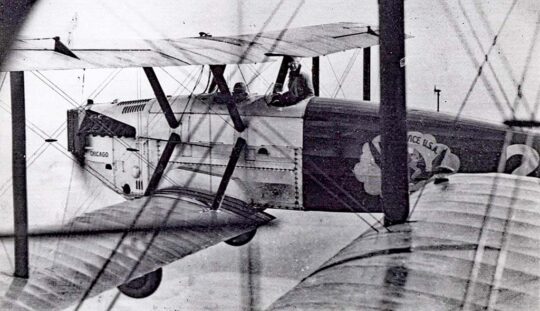
In April 1924, eight U.S. Army Air Service pilots and mechanics in four airplanes left Seattle, Washington, to carry out the first circumnavigation of the globe by air. Only one completed the entire journey 175 days after 74 stops and flying about 27,550 miles.
Amazingly, 35 replacement engines, along with numerous spare parts, had been distributed throughout the world to assist the effort.
In contrast, our trike adventurers had but one engine and only each other to support a voyage four times as long as the 1924 group. No wonder Rotax was pleased to help report the following story.
Trike Globetrotter Project
As Rotax Aircraft Engines observed from their base in Gunskirchen, Austria, “To travel around the world in a trike is an adventure that is not for everyone. Two extreme adventurers from Germany, Andreas Zmuda and Doreen Kroeber fulfilled their dream that became the philosophy of their life.”
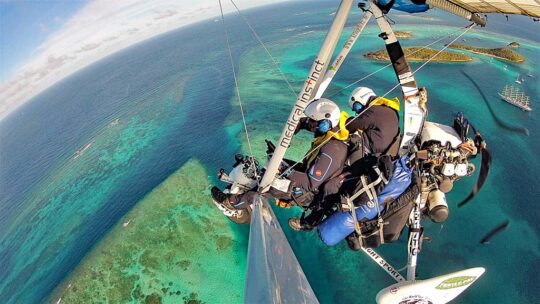
The big engine builder supplied the 912 ULS/S powerplant. which got one long workout as Andreas and Doreen flew their French-built 2012 DTA Voyageur II weight shift trike.
A point of irony — The DTA-brand trike is the same as world-circler and founder of The Airplane Factory, Mike Blyth used for his 1999 South to South (as in S. America to S. Africa) expedition. As fantastic as that expedition was, the Trike Globetrotters flew nearly four times as many miles.

After earning his Sport Pilot certificate in the USA, Andreas decided to stay in South America where he worked for 22 years as a tour guide and organizer of adventurous tours and jungle expeditions.

Doreen was born in Halle, Germany and since her teenage years has been interested in outdoor activities and adventurous trips around the world.

These extreme adventurers have been flying together over the past years across North, South and Central America. In New York, they made a spectacular flight around the Statue of Liberty and through the skyscrapers of Manhattan (images), a top highlight of their travels.

“We knew from the very beginning that we would fly more than a third of all our flights over water, jungles, or mountains, where safe emergency landing is impossible,” said Andreas about the most nerve-racking stages of their trip. “You never get used to flights like the ones over the Darién Gap between Panama and Columbia with 350 kilometers (217 miles) of uninhabited jungle, or the Arctic tundra of Canada, or even the many anxious flights of up to four hours over the turquoise blue water between the Caribbean islands.”
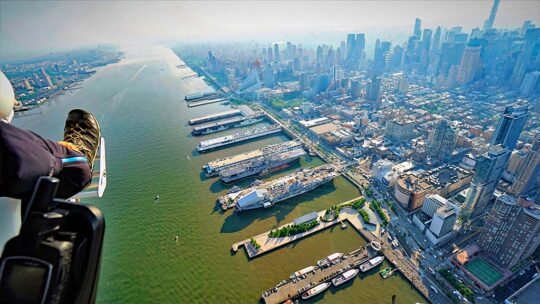
Flying over the Hudson River in New York City, a highlight of the entire flight, they said.
“But it was always an extremely good feeling to be able to fully rely on the Rotax 912 ULS/S,” Andreas stated. In 2018 the pair returned to Europe, where they flew from Belgium to Luxembourg, to Germany, Switzerland, The Netherlands, Denmark and to Sweden, Norway, Finland as well as from Estonia to Latvia, Lithuania, Poland, Czech Republic, Slovakia, Hungary, Slovenia, Italy, France, Spain, and Portugal.
Later stages of their trip took them into Africa – over fields, deserts and mighty mountain ranges – and then across Asia to the final goal of the world tour: Australia.
“It is still a huge distance to fly for the adventurers,” observed Rotax, “which implies a lot of dangerous areas but also gorgeous experiences, impressions, and encounters.
Pilots may dream about being such an experience, yet few would have the courage to set off on such an adventure. Fortunately, you can enjoy the magic from the comfort of your sofa.
See the Movie Support the Effort
“Financing an experience like this is no easy task,” Andreas and Doreen said. “You can help us by renting or buying the trike adventurers’ movie: “100,000 Miles: The Adventures of the Trike-Globetrotters on the American Continent . Check out the trailer below and go to this link to rent ($6.50) or buy ($15, stream anytime). See a trailer below.
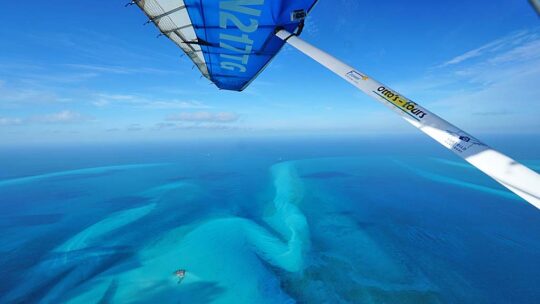
Keep up with these adventure partners at their Trike Globetrotter website .

In this English-language trailer for their full-length movie, you get a taste for the globe-trotting adventure this pair experienced as well as their movie-making skills.
November 21, 2022 at 5:13 pm
DID THEY CALL AHEAD?
seriously, how did they do that? musta been their good looks and great personalities.
Leave a Reply Cancel reply
Your email address will not be published. Required fields are marked *
Notify me of follow-up comments by email.
Notify me of new posts by email.
This site uses Akismet to reduce spam. Learn how your comment data is processed .

The Ultimate Guide to Planning the Round the World Trip of a Lifetime

After planning 10 around the world trips, I’ve learned a few things. Here’s how to plan your dream RTW vacation, from Round the World flights to choosing your Bucket List itinerary.
Let’s face it, the pandemic was a punch to the gut for travel lovers around the world.
Never did I think I’d see a day when I couldn’t just bebop onto a transatlantic flight. Or just, say, leave my own home. But there we were.
When I (literally) dusted off my passport in early 2021, the thin layer of dust accumulated was borderline soul crushing.
But thankfully, the pandemic era is finally in the rearview mirror and international travel has rebounded with a heart-warming zeal in the years since!
Note: This post may contain affiliate links. If you choose to book through these links, I receive a small commission, which I will undoubtedly blow on more flights (it’s a vicious cycle). All of this internet voodoo takes place at no additional cost to you.
So now what?
You’ve got some lost time to make up for, that’s what.
And there’s no better way to do it than with a life-changing, Bucket-List-crushing, dream vacation around the world .
Take my word for it…I’ve done 10 around the world trips, visiting more than 175 countries on all 7 continents along the way.
And you can, too.
But I probably don’t need to waste my time selling you on the idea of a trip around the world. You found this site. I suspect you’re on board.
So let’s start with the basics.

What is a Round the World Trip?
Simply put, a Round the World (RTW) trip is a circumnavigation of the globe, either in an eastward or westward direction. Start in one city and continue east or west until you get back to it.
That’s all there is to it!

Tip: West is best for combatting jetlag, while East saves time and hotel nights ($$) with overnight flights. (I’m cheap and usually short on time, I fly East. )
Read More: 8 Reasons to Stop Dreaming & Start Planning a Trip “Around the World in 30 Days “
Of course, while the concept of round the world travel is simple, the variables are far more complex.
For example, you may be wondering…
How many days do I need for a Round the World trip?
What you’ve probably seen on YouTube and Instagram from round the world travelers is true.
Most quit their jobs, sell their possessions, and hit the road for a year or more with big dramatic flair. Of course, that kind of nomadic commitment is not for everyone.
And I’m living proof that there are other options.

My first 9 RTW trips were approximately 30 days each. The lone exception was RTW #10, my honeymoon , which clocked in at a pretty incredible 3 months.
I’ve also done 30-day trips focused on various regions of the world like Europe , Central America , Oceania , the Balkans , and the Himalayas (a great option if there’s a specific part of the world that interests you or you just hate jetlag).
For me, a month is the ideal amount of time to travel.

Long enough to truly disconnect and explore.
Yet short enough that I’m unlikely to throw my carry-on (we’ll get to that) suitcase out the nearest train window because I’m tired of every single thing in it.

There’s no right answer to how long your round the world trip should take. I know someone who went around the world in 5 days (zero stars, do not recommend) and someone else who started 10 years ago and is still going strong.
So, two weeks, a month, or even 6 months to travel around the world? It’s totally up to you.
The bottom line: Take as much time as you can, anywhere from 2 weeks to 2 months will do. If 2020 taught us anything, it’s that you never know if you’ll have the chance to do it again.

A trip around the world sounds amazing, but how do I get the time off?
When I wrote the first edition of The Grown-Up’s Guide to Globetrotting 12 years ago, this topic was a central focus and the largest hurdle to taking a career-friendly trip around the world.
After all, most Americans are stuck with a measly 2 weeks of annual vacation leave (the horror!).
So, how do you travel around the world without tanking your career?
Amazingly, on this front, the COVID-19 pandemic gifted us with one gleaming silver lining:
WORK. FROM. HOME.
Yes, even the stuffiest of Fortune 500 corporations have finally come around to the idea that work from home can (and does) work – with the right employee.
This revelation is especially thrilling to me as someone who has been working from home (combined with business travel) for more than 20 years.
In fact, my friends will tell you that my life mantra has always been:

Or Paris. Or Bangkok. Or wherever floats your boat.
You get the idea.
There’s a lot more to making this work successfully from exotic locales – time zone challenges, reliable internet, etc. (I go into that in detail in the book) – but I can assure you, it can be done.

And it beats the pants off working from your dining room table.
The bottom line: You can use the WFH option to increase your available time for travel. Add days or weeks onto your trip or schedule a trip just to work from somewhere inspiring.

What’s on your Bucket List?
And now we come to the fun part. This is where the magic happens.
Where in the world do you want to go?
I speak from experience when I say that there are few things more thrilling than sitting down in front of a giant foldout map of the world and plotting out your dream vacation .

Maybe you already have a dozen exotic destinations in mind. Or maybe there are places in the world you never considered visiting because they always seemed too far away.
The beauty of going around the world is that the entire world becomes just a short flight away.

How many destinations should I choose?
The answer will directly correlate to how much time you plan to take. My 4 week round the world trips have ranged from an uber-ambitious 15 stops on Round the World #1 to a more relaxed pace with 8 stops on Round the World #2 .
Here’s a simple, 3-step plan for crafting your round-the-world trip itinerary:
- Make your wish list.
- Compare it to the number of days you have to travel.
- Adjust accordingly.
Critically evaluate how long you actually need to see each desintaiton on your wish list.

For some (like me), 2-3 days per destination can be a good rule of thumb.
Devote more time to your “ Top 5 ” must-see destinations and maybe just spend one day exploring the city you only added to the itinerary because it was right there and you couldn’t just skip it (you laugh, but I guarantee a few of these stops will sneak their way onto your itinerary!).
Remember that a 4 week round the world trip, however incredible, is not going to be an in-depth cultural experience at every stop.

Think more Amazing Race and less Under the Tuscan Sun .
It IS, however, a terrific way to get a taste of new and exciting places and start building a new wish list for future trips.
Depending on your interest level, you may not need a week to see the Pyramids , I did it in an afternoon and it was magnificent.
A full day at the Taj Mahal and a morning walk along the Great Wall of China were enough to fulfill my dream of seeing those world wonders.
But that’s me. And I’ve been told I can be a little, ah, overly-energetic when I travel.
You do you.
Need some destination inspiration? Here are 30 of my favorite travel experiences around the world:
Around the World in 30 Extraordinary Travel Experiences

And here are the Top 50 places I think should be on every Travel Bucket List:
50 Amazing Places for Your Travel Bucket List (2024)

Round the World Flights: The RTW Ticket (your new best friend)
I am fortunate that my years of excessive business travel have one nifty little side benefit, I have a crap ton of airline miles.
So when I discovered the magical world of “ Round the World airline tickets ” years ago, those Delta miles not only afforded me the opportunity to take that first RTW trip but to take it in first class with Delta’s Skyteam Alliance.

Sadly, the days of booking a RTW ticket with miles went the way of the dodo bird in 2015. I won’t lie to you, I wept openly when Delta first announced it (followed quickly by United and American).
But all is not lost if you’ve been hoarding miles like pandemic toilet paper. All major US airlines now allow one-way award booking. This means you can still use your miles to route yourself around the world, one one-way flight at a time!

And honestly, the old mileage RTW tickets were a deal but they were a BEAR to book and had zero flexibility.
One-way award booking gives you a ton more flexibility plus the option to mix economy and business class legs (for longer flights) on your journey.

This is a BIG perk.
Here are a few more tips for you “ Up in the Air ” business travelers out there with miles & points to burn:
How to Use Points & Miles to Redeem Your RTW Dream
No miles, no problem
Two of the three major airline alliances do still offer paid RTW ticket options. Delta’s Skyteam Alliance is the exception, they discontinued the RTW ticket option completely a few years ago.
There are pros and cons to booking a round the world ticket with an airline alliance:
- Cons – Airline alliance RTW tickets are not cheap and you’ll spend extra time connecting through hub cities to get where you want to go.
- Pros – You can earn a ton of miles (and airline status) as you travel and those extra cities can be fun stopovers. Plus, if you already have status with an airline in the network, you’ll get lots of extra benefits like free checked bags and early boarding.
If that option interests you, start here:
- Oneworld – World Travel (American, Alaska)
- Star Alliance – Round the World (United)

The affordable RTW ticket…
If redeeming (or earning) miles isn’t your jam and you truly just want the most affordable way to see the world, skip the airline alliances and head straight to:
- Airtreks – This site is more service oriented, you enter a proposed itinerary and a travel planner will contact you to create the perfect customized itinerary.
- BootsnAll – This one is more DIY. You can create and book an itinerary yourself online.
Unlike the airline alliances, these two round the world airfare specialists utilize all airlines to create your dream itinerary. This will often yield both the best price and the most direct routing for your trip.
WARNING: Once you start playing around with the trip planners on these two sites, you may become addicted to the global possibilities.
Tip: You guessed it, I’ve covered all the ins and outs of booking RTW tickets in the book.
Hotels vs. Airbnb – Where to stay?
Once again business travel rewards can be handy when planning trips around the world.
My Marriott and Hilton points have been offsetting the costs of my round the world trips for years. Not to mention affording me swank rooms at hotels and resorts that were WAY outside of my round the world budget, like these:
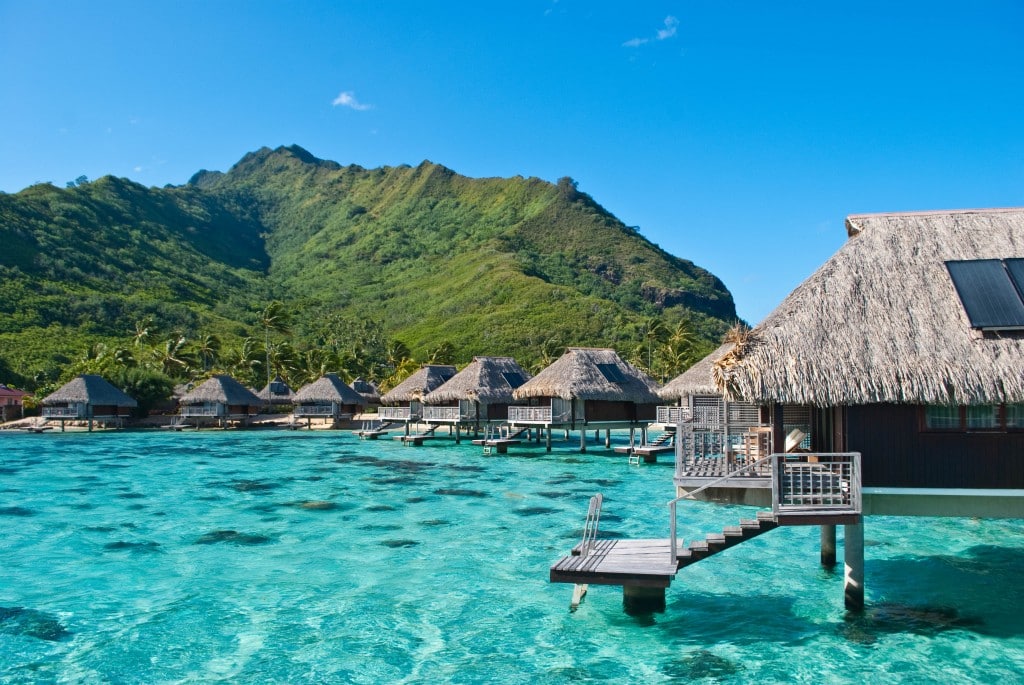
But if you don’t have points, not to worry!
I am a firm believer that a quality, affordable hotel can always be found, even in the most expensive destinations. My go-to hotel site (when I’m not using points) is Booking.com .

Tip: If you’re not a member of any hotel frequent guest programs, sign up for all of them before you go. It’s free and you’ll earn points as you travel. Many also offer perks during your stay, just for being a member.
If you’re not a fan of chain hotels or if you’re going to be in one spot for more than 3 or 4 days, I’d highly recommend an apartment rental. They can be considerably cheaper than even the most economical hotel, and having a kitchen can also be a tremendous cost-saver.
Not to mention it’s just fun to live more like a local!
One of my favorite apartment rental sites is Airbnb but I’ve also found that more and more apartment rentals are also listed on Booking.com (and the fees there are often cheaper than Airbnb). That said, I’ve booked with Airbnb all over the world (including the Tuscan villa we used for our wedding – below!) and never had a bad experience.

Who should I travel with on an around the world trip?
If you’re married, it would probably be rude to go without your spouse (try it at your own marital peril).
But if you’re single, this is a question that deserves serious consideration. If you’ve never traveled solo, your gut instinct may be to find a friend or family member to travel with.
But before you do that, consider this…

A solo trip around the world is perhaps the best gift you can ever give yourself, especially for women. It’s empowering, it’s safe and it just might be the best travel experience of your life.
Read More: Why Every Woman Should Travel the World Solo (at Least Once) & How to Stay Safe Doing It

So yes, it’s perfectly fine (and perhaps even preferable) to travel round the world solo.
No matter what you decide, choose carefully.

How to pack (carry on only!) for an around the world trip
Yes, you read that right. I just casually floated the idea of traveling around the world for a month or longer with nothing but a carry-on bag.
If you’re a guy, you were probably not at all alarmed by the previous paragraph and thought, “ Couple of t-shirts, some shorts, underwear, got it. ” You can scroll down to the next topic, this section is not about you.
Now, for my globetrotting ladies. I’m going to ask you to trust me on this one. We’ve known each other for 10 or 15 minutes now and I feel like you get me.
With so many flights involved in an around-the-world itinerary, carry-on is truly the only option.
Reuniting with a lost bag can quickly become a logistical nightmare when you’re changing cities every few days. (And I can assure you that no one at the lost baggage desk understands what “ RTW ticket ” means.)
If you don’t believe me you can read all about the one time I broke my own rule and ended up spending an entire day at baggage claim in Paris on Round the World #4 . (Actually, don’t. It’s mind-numbing reading and definitely not my best work.)

You can do this. You don’t need all the “ stuff ” you think you do!
(For the things you do need, here’s all the Stuff I Love most!)
I have traveled for as long as 3 months out of just a carry-on (and in case I forgot to mention it, I’m a girl!). I do freely admit, however, that I was over just about every item of clothing in that suitcase by the end.
I also confess I checked a bag to Antarctica. Because Antarctica .

How do I do it? This excerpt from “ The Grown-Up’s Guide to Globetrotting ” is guaranteed to help you overcome your RTW packing challenges:
How to Travel Around the World with Just a Carry-On: A Girl’s Guide to Traveling Light
What else do I need to know for a RTW trip?
We’ve covered the big-ticket items – how long to travel, how many places to visit, with who, how to find RTW tickets, where to stay, and what to pack.
So what’s left?
Well, a LOT actually. But hey, that’s where my book comes in (insert shameless plug here).
I’ll end with a hit list of other tips, tricks, and things to consider when planning your once-in-a-lifetime (or maybe more!) round the world trip:
- Apps : For currency conversion, I like the Oanda app. And Google Translate is also a life saver.
- Thoroughly research entry requirements for ALL countries you plan to visit well in advance. Almost all visa applications can now be completed online.
- A good universal power adapter & converter is a must. More than one is a plus if you have lots of devices (and don’t we all these days?).
- Check with your doctor for any immunizations you may need for your destinations. I got the works before my first trip and haven’t had to worry about it since (other than the occasional prescription for malaria pills).
- Consider purchasing travel insurance, for a trip of this magnitude, it’s a must! Especially in the post-pandemic era. Here’s a good independent review of the benefits of travel insurance and the options available: 10 Best Travel Insurance Companies
- Make sure your passport is valid for at least 6 months after your planned date of return because all countries have different requirements on this.
And finally…

Get the Book!
For more comprehensive advice on planning your around the world itinerary, booking Round the World tickets, and everything else you ever wanted to know about travelling around the world, get the ultimate Round the World trip planner:
Round the World in 30 Days: The Grown-Up’s Guide to Globetrotting
Now get out there and start planning the around the world trip of your dreams!
As Phil Keoghan says at the start of every season of the Amazing Race,
“The world is waiting for you!”
- Cast & crew
- User reviews
Sky Captain and the World of Tomorrow

After New York City receives a series of attacks from giant flying robots, a reporter teams up with a pilot in search of their origin, as well as the reason for the disappearances of famous ... Read all After New York City receives a series of attacks from giant flying robots, a reporter teams up with a pilot in search of their origin, as well as the reason for the disappearances of famous scientists around the world. After New York City receives a series of attacks from giant flying robots, a reporter teams up with a pilot in search of their origin, as well as the reason for the disappearances of famous scientists around the world.
- Kerry Conran
- Gwyneth Paltrow
- Angelina Jolie
- 672 User reviews
- 93 Critic reviews
- 64 Metascore
- 8 wins & 19 nominations

Top cast 42

- Polly Perkins

- Sky Captain

- Editor Paley

- Mysterious Woman

- Dr. Totenkopf
- (archive footage)
- (as Sir Laurence Olivier)

- Dr. Jennings
- Dr. Kessler

- German Scientist
- Executive Officer
- Communications Engineer
- Uniformed Officer
- Kalacakra Priest
- All cast & crew
- Production, box office & more at IMDbPro
More like this

Did you know
- Trivia As Sky Captain and Polly Perkins fly submerged with "The Amphibious Squadron", they "overfly" a sunken steamer named "Venture". It's the ship used to bring King Kong (1933) to New York City. It even includes, on its deck, a cage large enough to confine Kong; implying perhaps that this is the original Skull Island.
- Goofs After the P-40 surfaces on Totenkopf's island, Polly sees the plane's registration "h11od" reflected in the water and one of the dashes is has moved, it reads "polly". In order to make the gag obvious, the filmmaker flipped the reflection horizontally.
[last lines]
[instead of taking a picture of the pods falling to Earth, Polly turns and snaps a shot of Joe]
Joe 'Sky Captain' Sullivan : Polly... you...
Polly Perkins : It's all right. You don't have to say anything.
Joe 'Sky Captain' Sullivan : Lens cap.
- Crazy credits Laurence Olivier is given a major on-screen credit, despite only being in the film through archive footage and having another actor voice his character's lines.
- Connections Featured in The Flying Legion Air Combat Challenge (2004)
- Soundtracks Over the Rainbow Written by E.Y. Harburg and Harold Arlen Performed by Jane Monheit Used by permission of EMI Feist Catalog Inc. Jane Monheit appears courtesy of Sony Classical
User reviews 672
- Jul 30, 2013
- How long is Sky Captain and the World of Tomorrow? Powered by Alexa
- What was in the vials?
- Why is Joe Sullivan called "Sky Captain?"
- September 17, 2004 (United States)
- United Kingdom
- United States
- The World of Tomorrow
- Chandler Valley Center Studios - 13927 Saticoy St, Panorama City, California, USA (World of Tomorrow stage photography)
- Paramount Pictures
- Brooklyn Films II
- Riff Raff Entertainment
- See more company credits at IMDbPro
- $70,000,000 (estimated)
- $37,762,677
- $15,580,278
- Sep 19, 2004
- $57,947,036
Technical specs
- Runtime 1 hour 46 minutes
- Dolby Digital EX
Related news
Contribute to this page.

- See more gaps
- Learn more about contributing
More to explore
Recently viewed.

IMAGES
VIDEO
COMMENTS
TikTok video from Travel Blogger (@pilotmadeleine): "Explore the world with Pilot Madeleine as she shares her adventures as a travel blogger and airline pilot. ... airline pilot, TikTok, travel influencer, adventurous pilot, aviation enthusiast, pilot lifestyle, globetrotting pilot, travel diaries. This information is AI generated and may ...
A pilot may acquire an affectionate awareness of a kind of punctuation or asterisking of the world, composed of the names of small places, places that almost no one other than pilots will have ...
Which City Would A Globe-Trotting Pilot Most Like To Ride In? ROAD. 06/26/2020 Shimano rider and photographer Daniel Hughes is known for his globe-trotting adventures with his bike, his camera and his riding companions. But with the world as it is at the moment, Daniel's travel has been seriously curtailed.
BIRMINGHAM, Ala. —. An aviation pioneer landed in Hoover Friday. Capt. Barrington Irving became the first Black pilot to fly around the world in 2007. Advertisement. He showed up at Hoover's Trace Crossings Elementary to inspire young minds about their limitless future. "That's changing perspective of what's possible.
Pilots: A chartered flight pilot is the primary role many think of when discussing this career. Pilots are in charge of navigating the jet safely. A pilot requires substantial training, typically acquiring a bachelor's degree in aviation, experience hours of flying, and completion of pilot training programs. ... Globetrotting: For those who ...
Globetrotting Leviathan: Graf Zeppelin's amazing voyage. One of the Americans on board the blimp was future Vice Adm. Charles E. Rosendahl, the U.S. Navy's top airship man.
Globetrotting careers present an alluring lifestyle for individuals driven by an unquenchable thirst for exploration and a fervor for embracing diverse cultures and destinations. Photo by Patty Brito on Unsplash ... Working as a flight attendant or pilot within the aviation industry grants unparalleled chances for continuous exploration and ...
Globetrotting Ryanair pilot reveals glamorous lifestyle with stunning Instagram snaps from cockpit and exotic beaches. Michelle Gooris has gained thousands of fans thanks to picturesque snaps of ...
How to Stay Healthy When Traveling - Six Steps You Can Start Today. Staying healthy when traveling is important, and your immune system is the first line of defense against infection, disease, and other illnesses. The following are healthy habits that can help maintain a strong immune system. Step 1: Protect Your Immune System from...
Barstow, California (CA), US. Solar One is a pilot solar-thermal project in the Mojave Desert just east of Barstow, California. Solar One was the first test of a large scale thermal solar power tower, power plant. Solar One was designed by the Department of Energy (DOE), Southern California Edison, LA Dept of Water and Power, and California ...
Globetrotting By Weight Shift Trike — Adventurers Fly 100,000 Miles In An Open Cockpit. ... modern, deluxe interior that any pilot can love. Airtime Aircraft (FlyCT.com), is the nation's largest seller of Light-Sport Aircraft, focused on the: CTLS and CT Super, the top-selling LSA in America. Airtime has represented Flight Design's CT series ...
1 of 13. CNN —. As a child, Lindy Kats was fascinated by the world of aviation. As a 24-year-old adult now working as a pilot with an incredibly popular Instagram account, the world of aviation ...
Tom Grond has been traveling the world for nearly 10 years, but he says it was his 2019 trip to Syria that had the biggest impact. Tom Grond. As social media began to evolve in the 2010s, and ...
A trip around the world sounds amazing, but how do I get the time off? When I wrote the first edition of The Grown-Up's Guide to Globetrotting 12 years ago, this topic was a central focus and the largest hurdle to taking a career-friendly trip around the world.. After all, most Americans are stuck with a measly 2 weeks of annual vacation leave (the horror!).
Embark on a journey of discovery with Globe Trotting Enthusiasts, your go-to travel blog for immersive adventures, cultural experiences, and uncovering hidden gems around the globe. Explore travel tips, inspiring stories, and expert insights to fuel your wanderlust. Join us on a virtual exploration of the world's wonders!
Pilot house from the S.S. William Clay Ford in Detroit, MI (Google Maps) Detroit, Michigan (MI), US. The SS William Clay Ford was a bulk freighter built for hauling material on the Great Lakes. She was named for William Clay Ford, Sr., grandson of Henry Ford, Sr. Her keel was laid in 1952 at River Rouge, MI by the Great Lakes Engineering Works ...
By bham121 @ 2016-11-21 18:59:22. Businessman and philanthropist Davis Pilot build this french chateau style home in the Country Club of Mobile. He owns Pilot Catastrophe Services along with his two brothers, whose Fairhope residences are also featured on this site. Links: www.pilotcat.com. 336 views.
But when events go drastically and violently sideways, in a direction and magnitude that no one could have ever imagined, he quickly learns control is an illusion. A nearly perfect life as a globetrotting pilot for hire, Steele, accompanied by his German Shepherd, Fritz, experience an abrupt and violent detour, their lives swept into chaos.
Jill Connett's constant in life has always been the passion she's nurtured since her days "playing teacher" with her childhood dolls.
Explore hidden gems and popular tourist attractions around the world with Globe Trotting Guide. Engaging storytelling and high-quality visuals take you on a virtual journey to showcase the beauty and diversity of cultures and landscapes. Plan your next adventure or seek inspiration with our travel-focused blog.
Sky Captain and the World of Tomorrow: Directed by Kerry Conran. With Gwyneth Paltrow, Jude Law, Giovanni Ribisi, Michael Gambon. After New York City receives a series of attacks from giant flying robots, a reporter teams up with a pilot in search of their origin, as well as the reason for the disappearances of famous scientists around the world.
Bing Maps. By bham121 @ 2016-11-21 18:55:40. Sonny Hill is the home and horse farm of Curtis Pilot, a principle of Pilot Catastrophe Services. The homes of his mother and two brothers are also featured on this site. Links: www.sonnyhillpolo.com. 420 views.